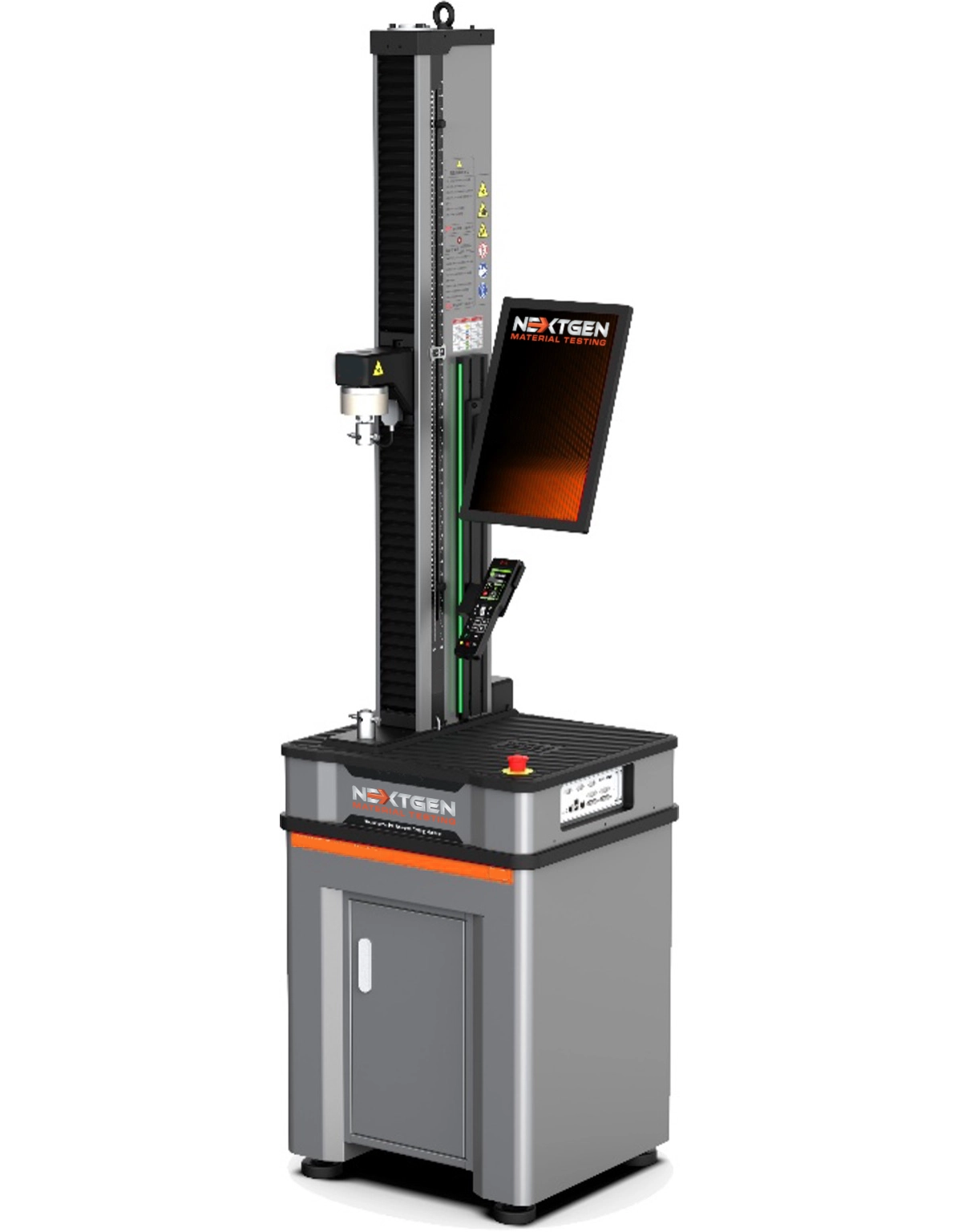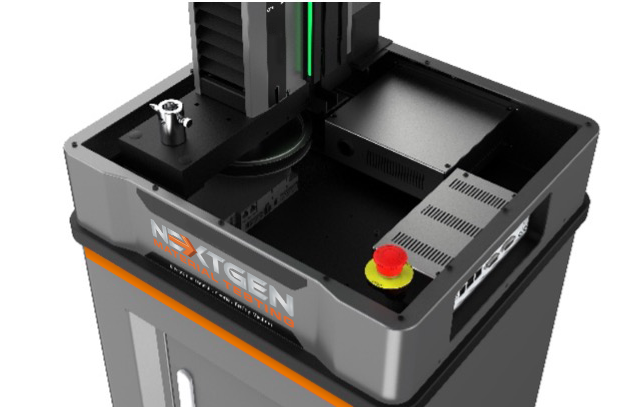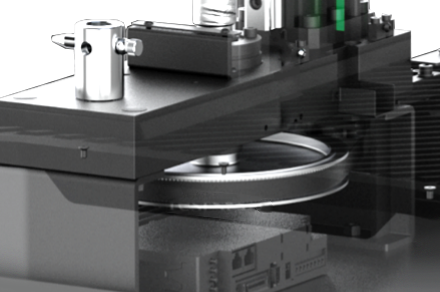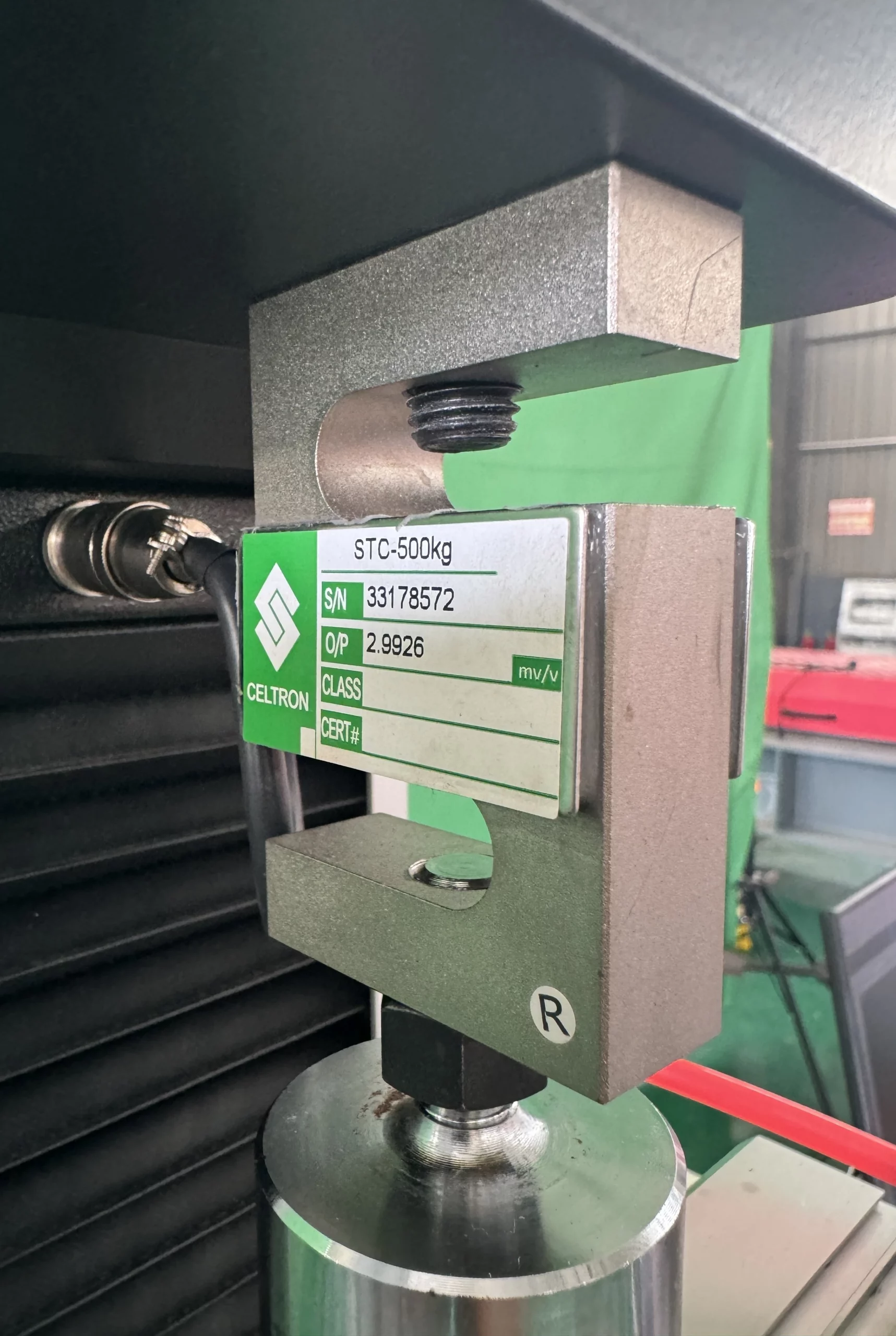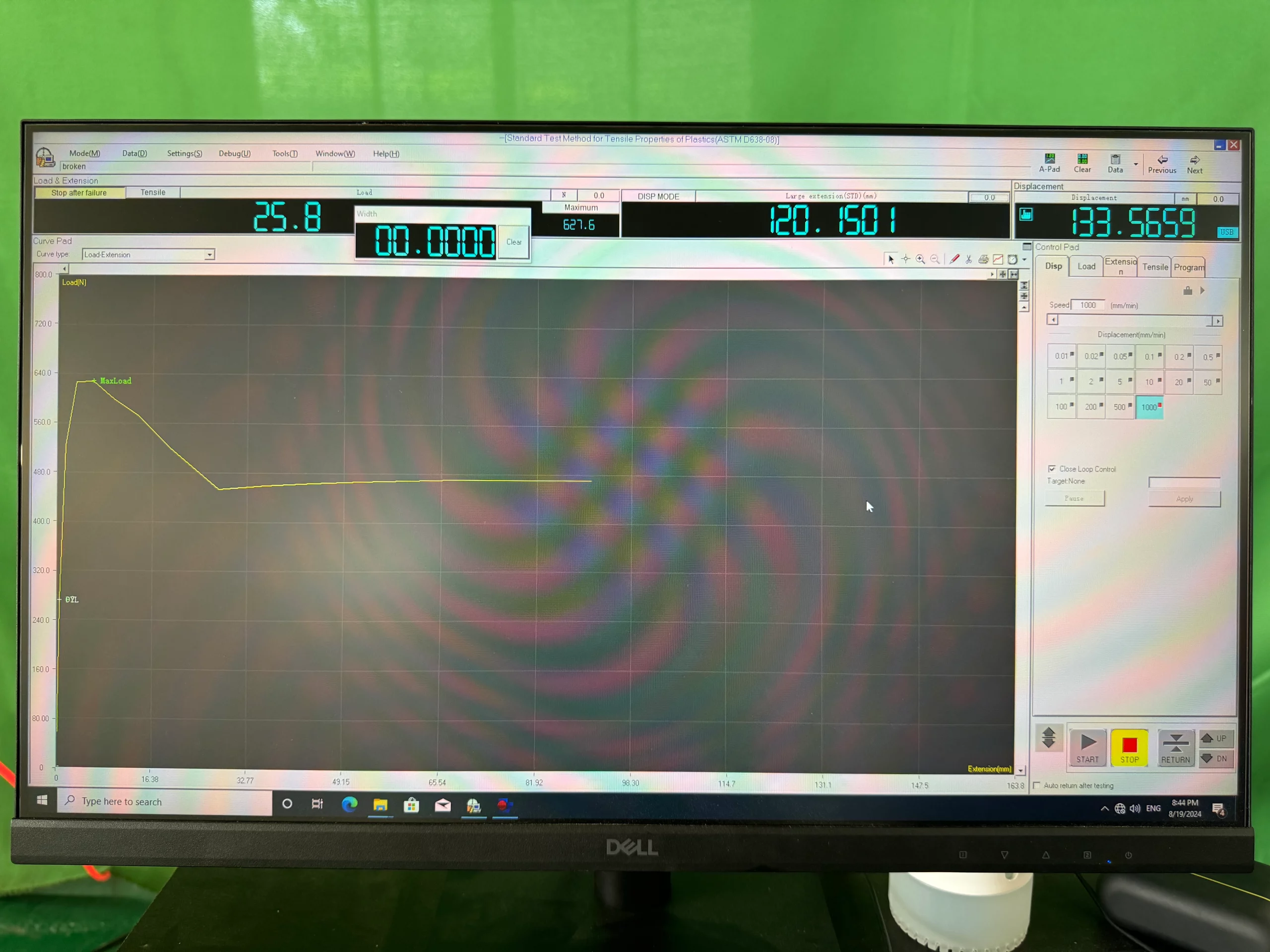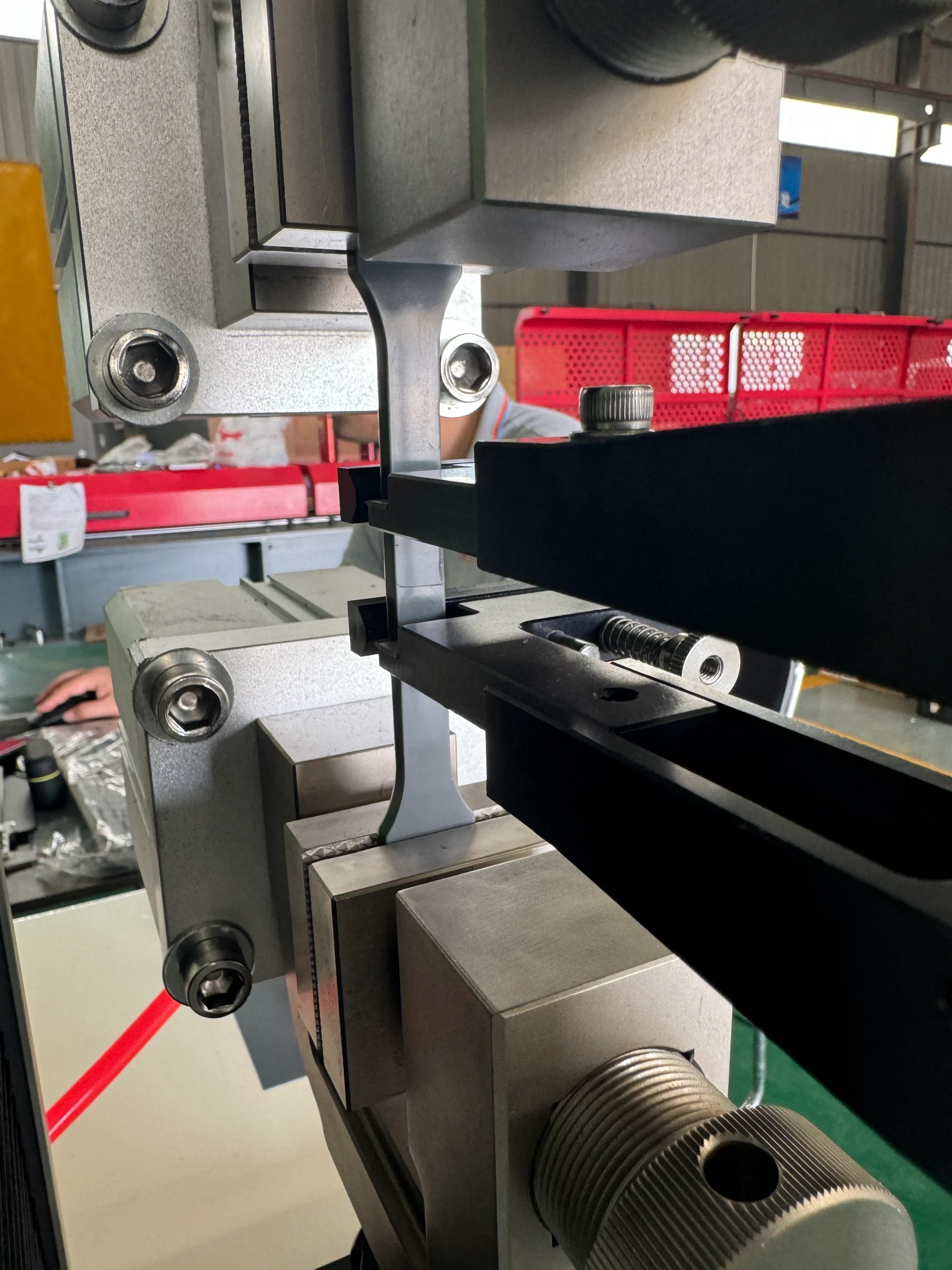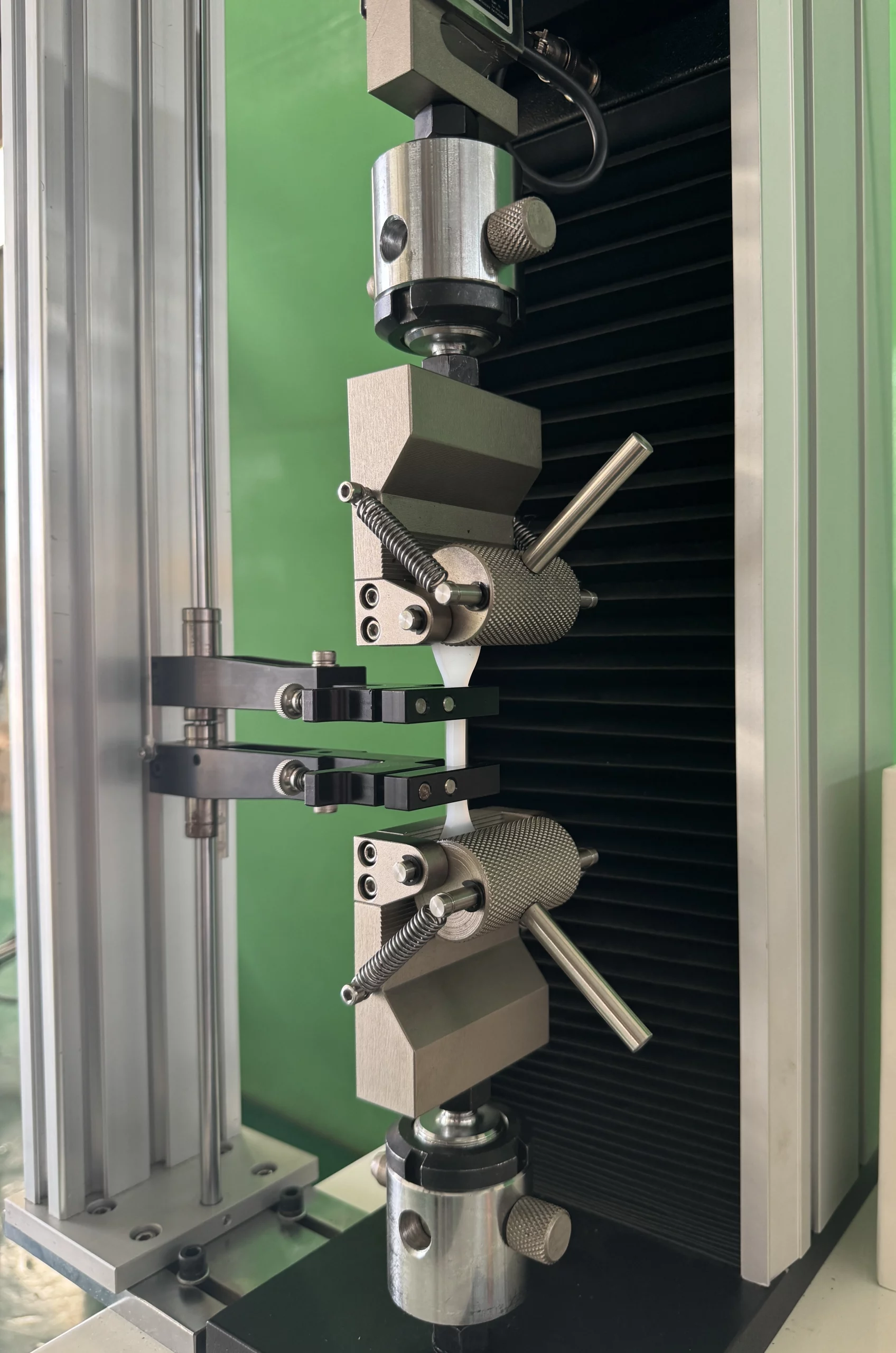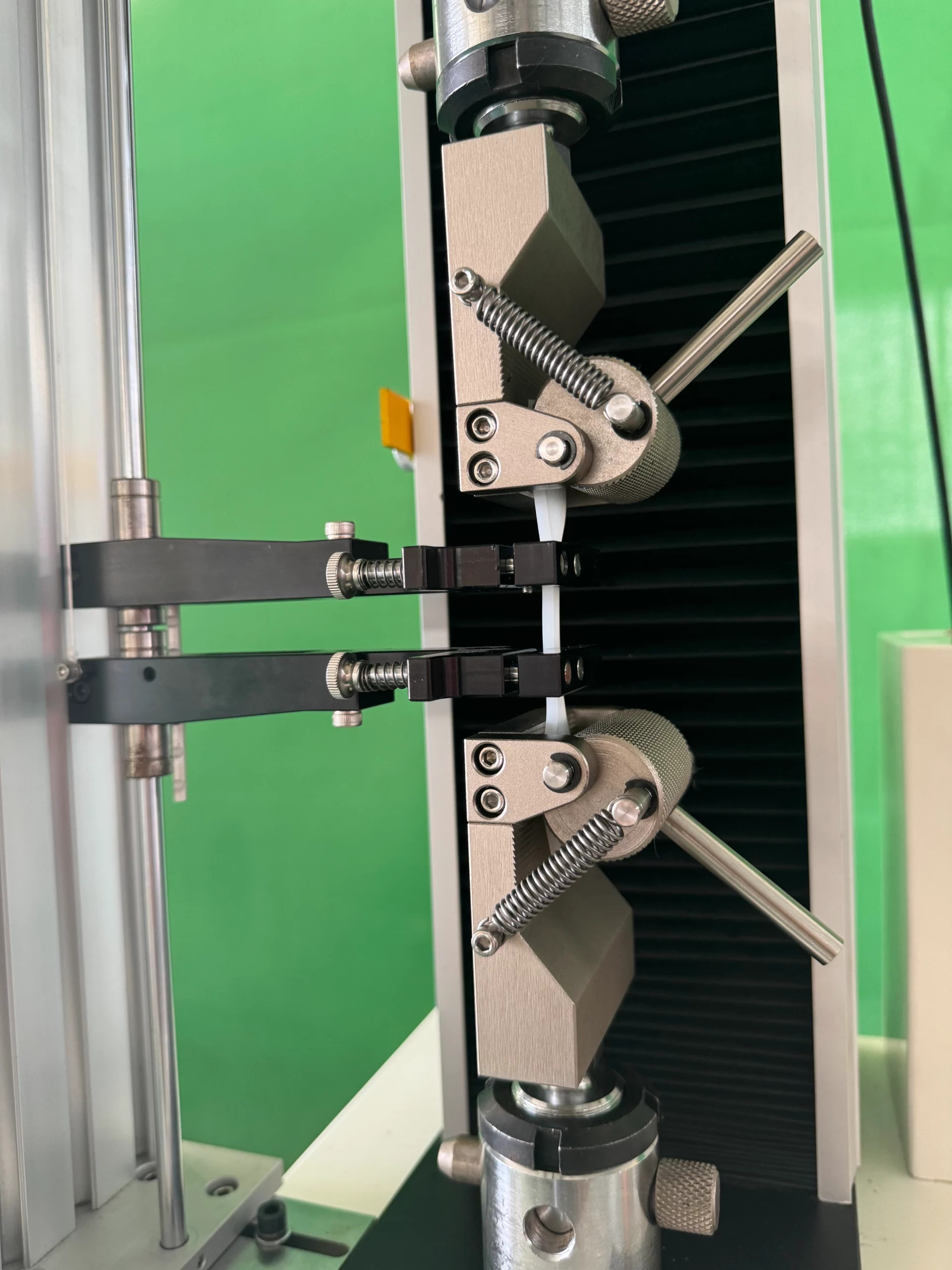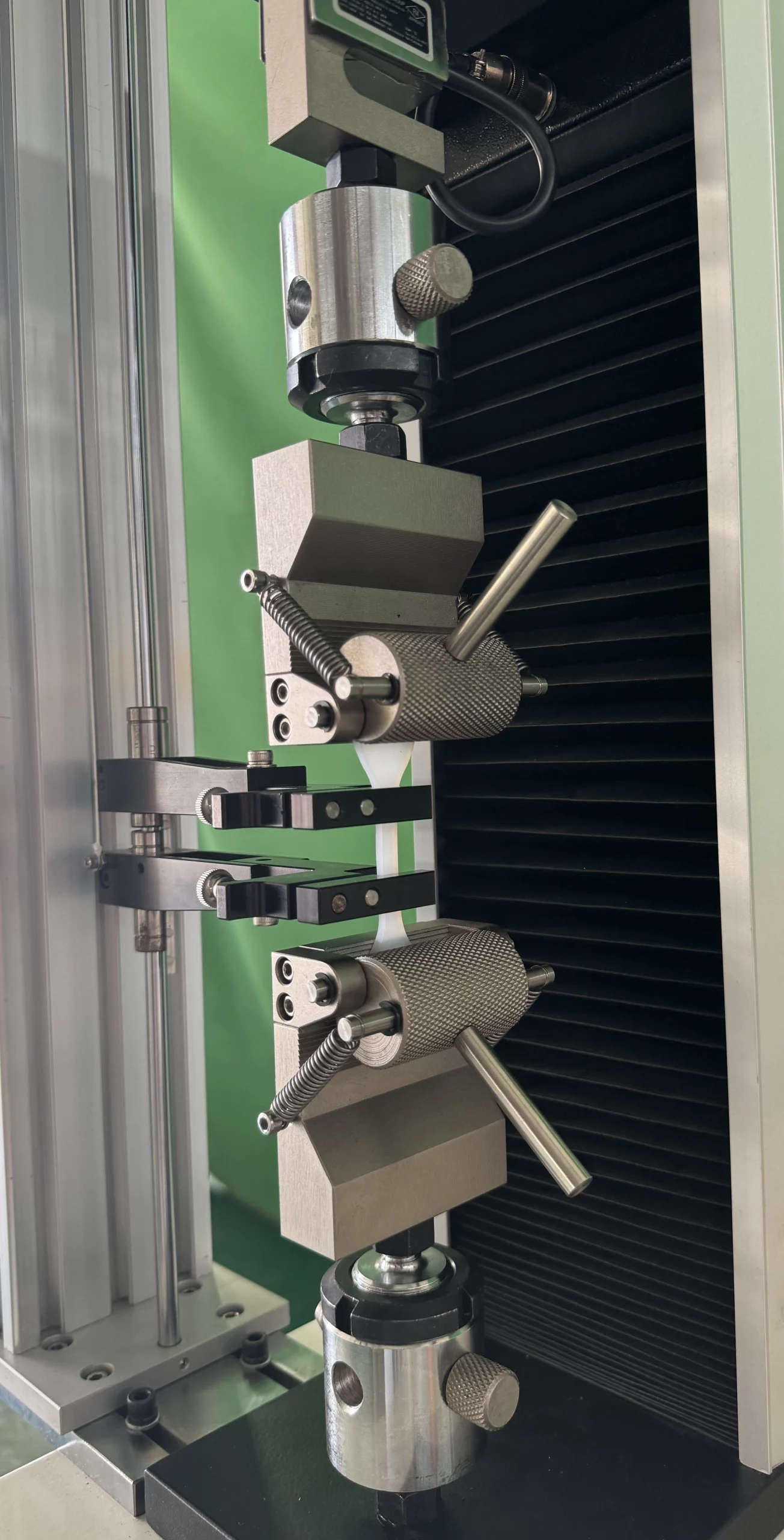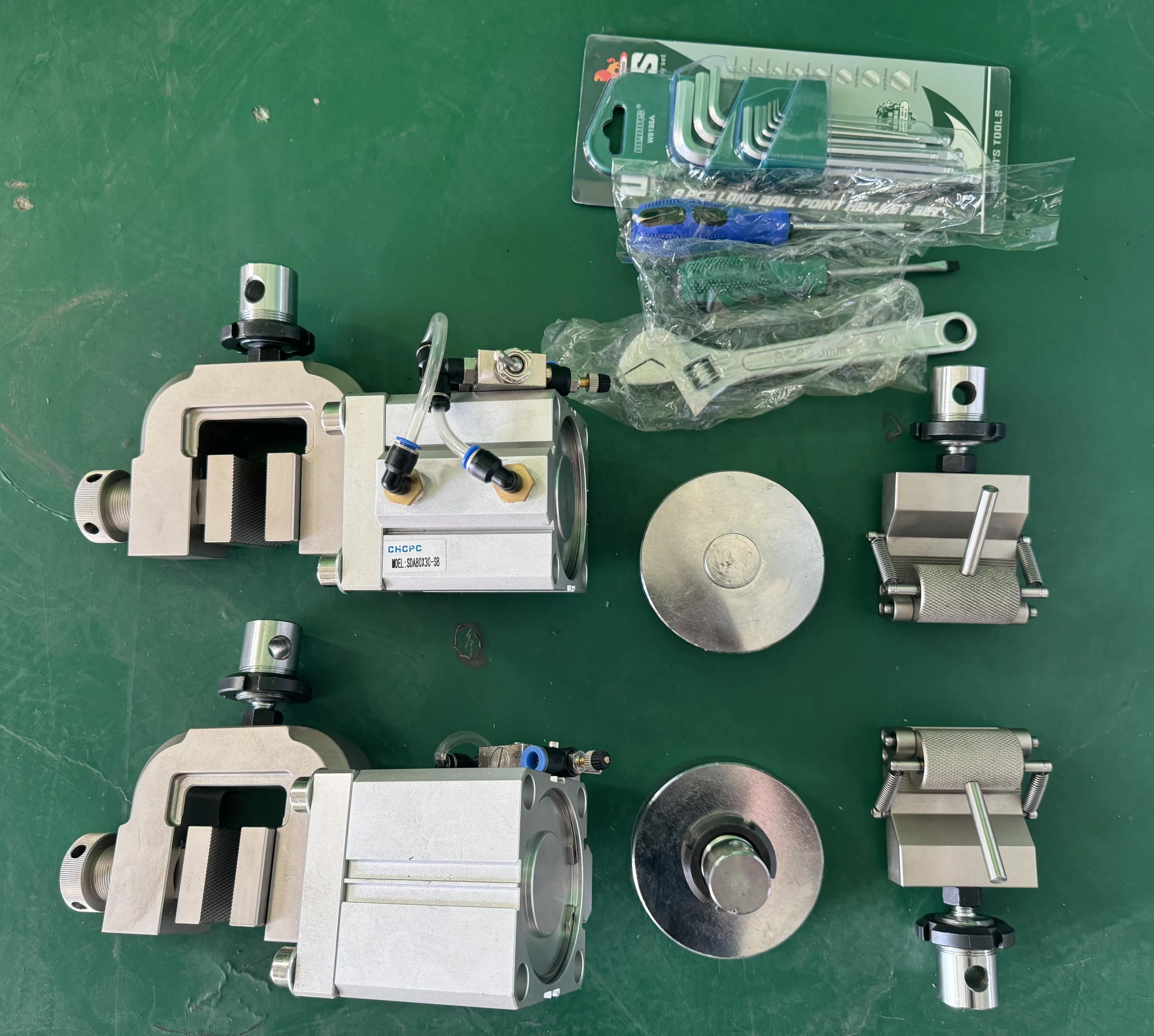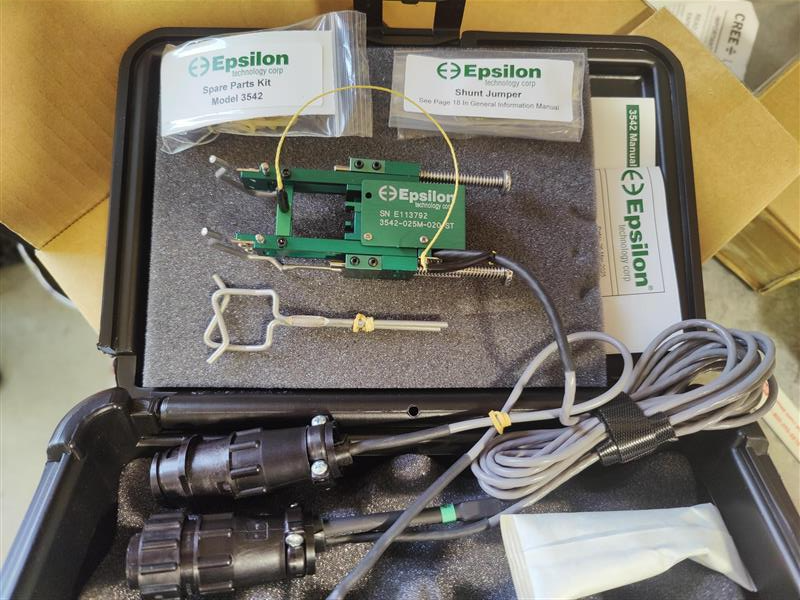Metal Testing Equipment
Standards
ASTM D412, ASTM E8, ISO 7500-1, ASTM E4, ISO 527, ISO 178, ISO 604, ISO 1184, ISO 37, ASTM D638, ASTM D790, ISO 6892






Description
The NG-EML Single Column Bench Top – Universal Testing Machine (50 N – 5 kN) is a next-generation electromechanical system built for both advanced research and routine quality control applications. Combining precision, speed, and compact design, the system offers a powerful solution for testing rubber, plastics, metals, composites, adhesives, films, foams, wires, and consumer goods under tension, compression, and flexure.
Force Capacity Options: 50 N (11.24 lbf), 100 N (22.48 lbf), 200 N (44.96 lbf), 500 N (112.40 lbf), 1 kN (224.80 lbf), 2 kN (449.61 lbf) , 5 kN (1124.04 lbf)
Frame Configuration: Single-column, table-top electromechanical frame
Test Space: Single-zone layout optimized for vertical displacement accuracy and consistent force application
Typical Applications: Material performance testing in R&D, production verification, education, and quality assurance. Especially suited for high-precision low-force applications and space-limited environments.
Typical Test Specimens
Below is a representative list of typical materials and components compatible with this testing system:
-
Plastics, fine wire, fibers, threads, biomaterials, thin films, adhesives, foam, packaging materials, paper products, and general consumer goods
-
Thermoplastics and thermosets (ASTM D638, ISO 527)
-
Elastomers and rubber compounds (ASTM D412, ISO 37)
-
High-strength composite materials and prepregs
-
Metallic wires, solder, and small components (ASTM E8, ISO 6892)
-
Biocompatible materials and medical samples such as films, sutures, and tissue substitutes
-
Packaging films, laminated paperboard, and coated paper (ISO 1924, ASTM D882)
-
Structural adhesives, sealants, and bonding tapes (ASTM D903, ISO 8510)
-
Soft and rigid foams (ISO 2439, ASTM D3574)
-
Textiles, including woven and non-woven fabrics, yarns, and geotextiles
-
Consumer product components such as plastic parts, clips, springs, and flexible displays
-
Optical films, membranes, and ultrathin multilayered structures
-
Thin metal sheets, metal foil, and small-scale electronic components (low-force range)
Key Features of the NG-EML Single Column Bench Top – Universal Testing Machine
The NG-EML Single Column Bench Top is engineered with advanced structural and control features designed to enhance performance and reliability. Key highlights include
-
Compact, rigid load frame
Sturdy, space-efficient single-column frame configurations, optimized for desktop use without sacrificing performance. -
FEA-optimized structural components
Column and crosshead designs feature enhanced rigidity to minimize deflection and maintain precise alignment under full load. -
High-speed, low-vibration drive system
Electromechanical direct-drive system with a high-rigidity synchronous belt enables crosshead speeds up to 2400 mm/min and return speeds up to 3000 mm/min, while minimizing mechanical noise and vibration. -
Pre-loaded precision ball screws
Axial preloading eliminates backlash, ensuring consistent force transmission and maintaining crosshead accuracy even during cyclic or dynamic loading. -
Linear motion guidance
Dual linear guide rails with precision bearings maintain coaxial alignment, minimizing lateral movement across the full stroke range. -
GenTest™ Universal Testing Software
Pre-installed software provides method templates for ASTM, ISO, GB/T, EN, DIN, and BS standards. Features include step-by-step test setup, automatic result calculation, real-time graphical output, and user access control levels. -
Digital closed-loop control system
Integrated 24-bit resolution controller with a 1200 Hz acquisition rate enables closed-loop control of force, displacement, and strain using optimized PID algorithms. Complies with ISO 7500-1 Class 0.5 and ASTM E4 requirements. -
Automated limit monitoring
Continuous real-time checks of crosshead travel, overload protection at 103%, system voltage, and motor temperature. Emergency stop functions and programmable stroke limits are integrated at both hardware and software levels. -
Wide selection of interchangeable accessories
Compatible with manual, pneumatic, and hydraulic grips; clip-on, laser, and video extensometers; temperature and humidity chambers; and torsional fixtures. All accessories use a modular plug-in interface. -
Safety-enhanced test space enclosure
Optional transparent protective shields with interlock logic are available. Shields are resistant to debris from specimen failure and automatically disable system movement if opened.
Control System
The NG-EML system incorporates a high-performance digital control unit designed for precise test execution, seamless communication, and enhanced system integration.
-
USB 2.0 Communication Interface
Data exchange between the machine and the host computer is handled via a stable USB 2.0 interface operating at 12 Mb/s. This connection supports multiple communication modes, including control, interrupt, bulk transfer, and real-time streaming. USB 2.0 is widely adopted in bench-top testing systems due to its reliable speed, plug-and-play compatibility, and electrical isolation. -
Alternative Connectivity – Ethernet (TCP/IP)
In addition to USB, the controller supports Ethernet-based communication through a dedicated high-speed logic chip with full TCP/IP protocol support. This enables low-latency, high-throughput data transmission—ideal for distributed testing setups or remote-controlled environments. -
Sampling and Acquisition Performance
The system provides 1200 Hz closed-loop sampling, allowing synchronized acquisition of force, displacement, and extensometer signals. A six-channel analog input module with 24-bit resolution ensures accurate, real-time signal capture and control. -
Integrated Hardware Protection
Embedded firmware performs continuous monitoring of voltage, current, overload conditions, motor temperature, and crosshead position. Both hardware- and software-based emergency stop logic are built into the system for added operational safety. -
Handheld Remote Console (Standard)
The system includes a 3.5-inch full-color touchscreen controller with an ergonomic silicone keypad and precision rotary dial. The remote unit enables:-
Start/stop test execution
-
Grip actuation
-
Crosshead movement and fine positioning
-
Return-to-origin function
-
Overload prevention logic
The remote can operate in standalone or PC-synchronized mode, providing flexible control redundancy across various test setups.
-
-
Standalone Control Option (Optional)
An optional industrial-grade touchscreen PC can be mounted directly on the machine frame. This configuration allows full test control without the need for an external computer, improving system mobility and simplifying usage in educational labs, mobile units, or multi-station environments.
Optimized Structural Rigidity
The NG-EML Single Column Bench Top UTM features a frame engineered for superior mechanical stiffness and durability. Utilizing a high-rigidity dual-rail structure and an FEA-optimized crosshead design, the system minimizes deflection and backlash, ensuring exceptional accuracy during critical measurements such as modulus determination, yield strength, and failure loads.
- The testing frame integrates preloaded precision ball screws, dual linear motion guide rails, and reinforced column supports to significantly reduce mechanical play.
- All interfaces — load cell, ball screw, motor couplings, and crosshead contact points — are engineered for zero-clearance under load, enhancing measurement consistency in both static and dynamic tests.
- The rigid design ensures long-term alignment stability, even during high-cycle or repetitive test applications.
Advanced Direct-Drive Servo Actuation
The NG-EML Single Column Bench Top – Universal Testing Machine features a next-generation direct-drive servo transmission system designed to deliver high speed, rapid acceleration, and precise control across all testing scenarios.
-
The system replaces traditional gear reducers with a high-rigidity synchronous belt and servo motor assembly, significantly improving mechanical efficiency and eliminating transmission backlash.
-
The crosshead achieves a maximum travel speed of 2400 mm/min and a return speed of up to 3000 mm/min, minimizing cycle time and increasing testing throughput.
-
The high-speed actuation system provides enhanced responsiveness for low-speed tests such as creep, stress relaxation, and modulus ramp procedures, while maintaining exceptional control during ultra-slow movements required for sensitive measurements.
-
Optimized acceleration profiles improve adaptability in complex test sequences, including multi-stage loading and high-speed ramp testing, without sacrificing positional accuracy or data integrity.
Integrated Safety and Intelligent Control Architecture
The NG-EML Single Column Bench Top – Universal Testing Machine is equipped with a comprehensive safety and control system designed to protect both the operator and the equipment while enhancing operational responsiveness and workflow efficiency.
-
Real-Time Collision Prevention
The system continuously monitors force feedback and motion data. If a sudden force anomaly is detected—such as from a specimen fracture or obstruction—crosshead movement is halted immediately to prevent load cell overload or mechanical damage. -
Overload Protection Logic
A hardware-level stop is triggered at 103% of the rated force capacity, safeguarding critical components and preserving long-term system integrity. -
Dual-Layer Position Limit Protection
Safety boundaries are enforced through both software-defined stroke limits and mechanical end-stop switches, ensuring reliable crosshead travel within safe zones. -
Emergency Stop Circuitry
Integrated emergency stop buttons provide the operator with immediate control to interrupt all machine motion in case of unexpected conditions. -
Sensor Range Enforcement
All analog input channels—including force, displacement, and extensometer—are monitored in real time. Built-in range validation prevents data distortion and protects against overrange input signals. -
Integrated Auto-Calibration and Diagnostics
The system supports internal load cell verification and automated self-diagnostic routines, helping to maintain continuous calibration accuracy and reduce maintenance downtime. -
Handheld Controller Safety Features
The included remote console features intelligent functions such as grip lockout, overload prevention, and a return-to-origin safeguard, reducing the risk of misalignment or accidental movement during setup.
Streamlined Operation and Maintenance
The NG-EML Single Column Bench Top – Universal Testing Machine is engineered for intuitive operation, reduced training requirements, and simplified maintenance—supporting efficient, uninterrupted performance in both laboratory and production environments.
-
User-Centered Software Workflow
The system runs on GenTest™ software, which features a clean, icon-driven interface. Preloaded test method templates for ASTM, ISO, GB/T, and EN standards enable fast test configuration, while drag-and-drop sequence creation and real-time graphical feedback streamline both basic and advanced testing procedures. -
Step-by-Step Configuration
Operators can construct test sequences through a guided setup process, minimizing the chance of error and ensuring consistent execution across different users and laboratories. -
Instant Report Generation
One-click data export, automatic calculation of key test parameters (e.g., modulus, yield strength, tensile strength), and batch processing tools simplify compliance documentation and quality reporting. -
Plug-and-Test Accessory Integration
All extensometers, grips, fixtures, and environmental chambers connect via modular interfaces with automatic recognition. Accessories can be swapped without requiring recalibration or software adjustments, significantly reducing setup time. -
Accessible Maintenance Architecture
The controller module is slide-mounted for easy servicing without disassembling the machine frame. Protective panels can be opened rapidly to allow direct inspection or replacement of belts, motors, or sensors. -
Dual Control Modes
The system supports full operation via either the handheld remote console or the optional industrial touchscreen PC interface, allowing flexible switching between local and PC-based control depending on the application—ideal for both training and production use.
Mechanical and Electronic Architecture
The NG-EML Single Column Bench Top – Universal Testing Machine is engineered with a precision mechanical structure and high-performance control electronics to ensure stability, repeatability, and accuracy across all test scenarios.
- High-Stiffness Linear Guide System: Dual linear guide rails with integrated self-lubrication significantly enhance lateral stiffness and ensure straight, low-friction crosshead travel. This design minimizes off-axis motion and maintains precise axial alignment, which is essential for reducing measurement error in displacement- and strain-sensitive tests.
- Low-Noise Synchronous Belt Drive: The direct-drive system employs a high-performance synchronous belt optimized for high speed and low vibration. It operates maintenance-free and ensures smooth power transmission between the servo motor and the actuator assembly.
- Integrated Optical Encoder: A high-resolution photoelectric encoder is embedded within the servo system to capture real-time position feedback of the crosshead, supporting micro-displacement measurements with 0.0133 µm resolution.
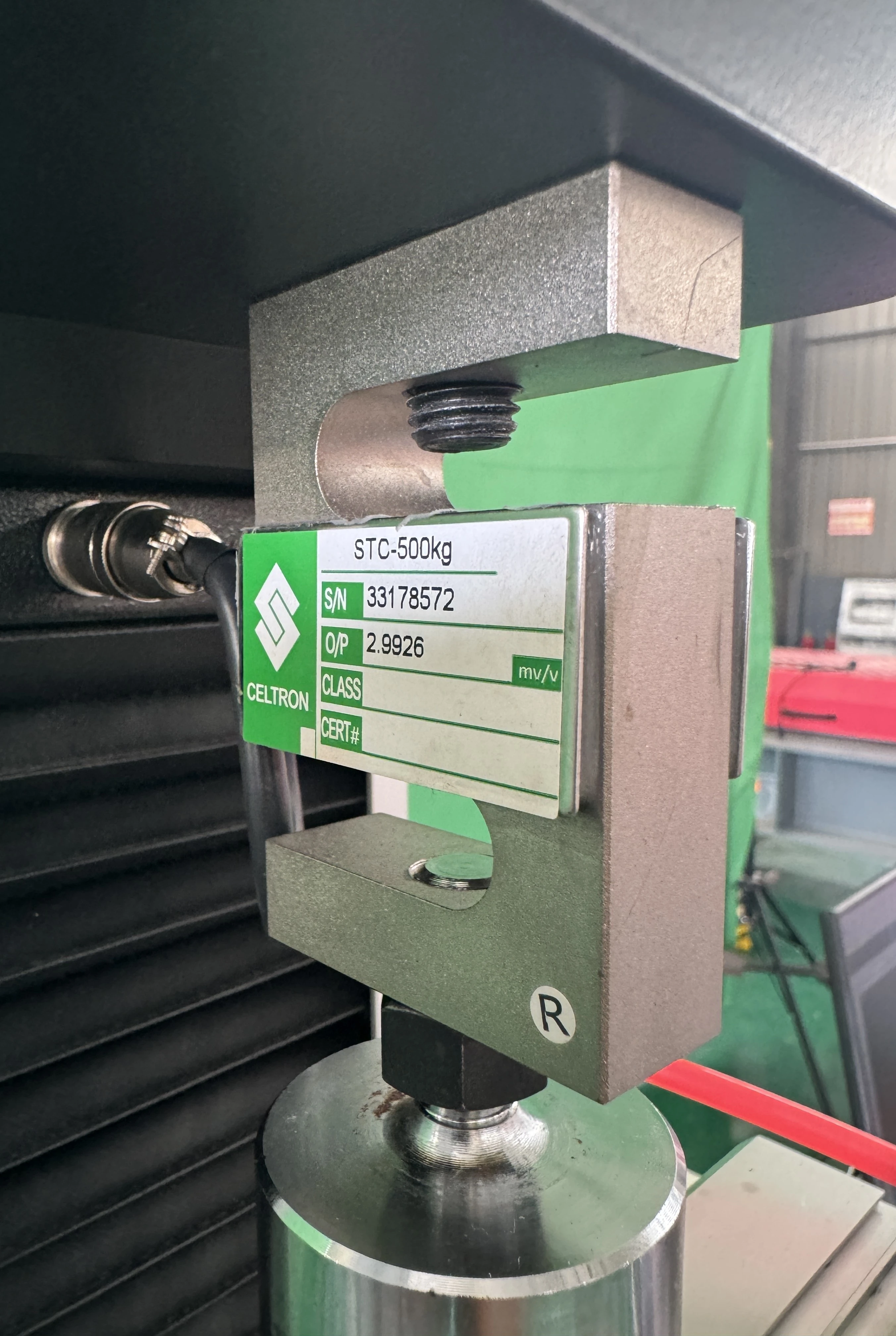
Load Cell Assembly
The system includes the following load cell features:
- High-Precision Load Cells: Each system includes a factory-calibrated load cell with high stiffness, minimal signal drift, and linearity across the entire rated force range.
- Overload and Lateral Force Protection: Built-in safety logic and structural reinforcement protect the sensor against shock loading, side forces, and improper specimen failure.
- Bidirectional Testing: The load cells support both tensile and compression tests without requiring reconfiguration.
- TEDS Auto-Recognition: All load cells are equipped with IEEE 1451.4-compliant TEDS chips, enabling plug-and-play recognition and eliminating manual setup.
- Self-Calibration Ready: The system supports internal load cell verification procedures to maintain measurement accuracy over time.
- Wide Operating Temperature Range: Rated from −55°C to +90°C, suitable for standard and environmental chamber-based testing.
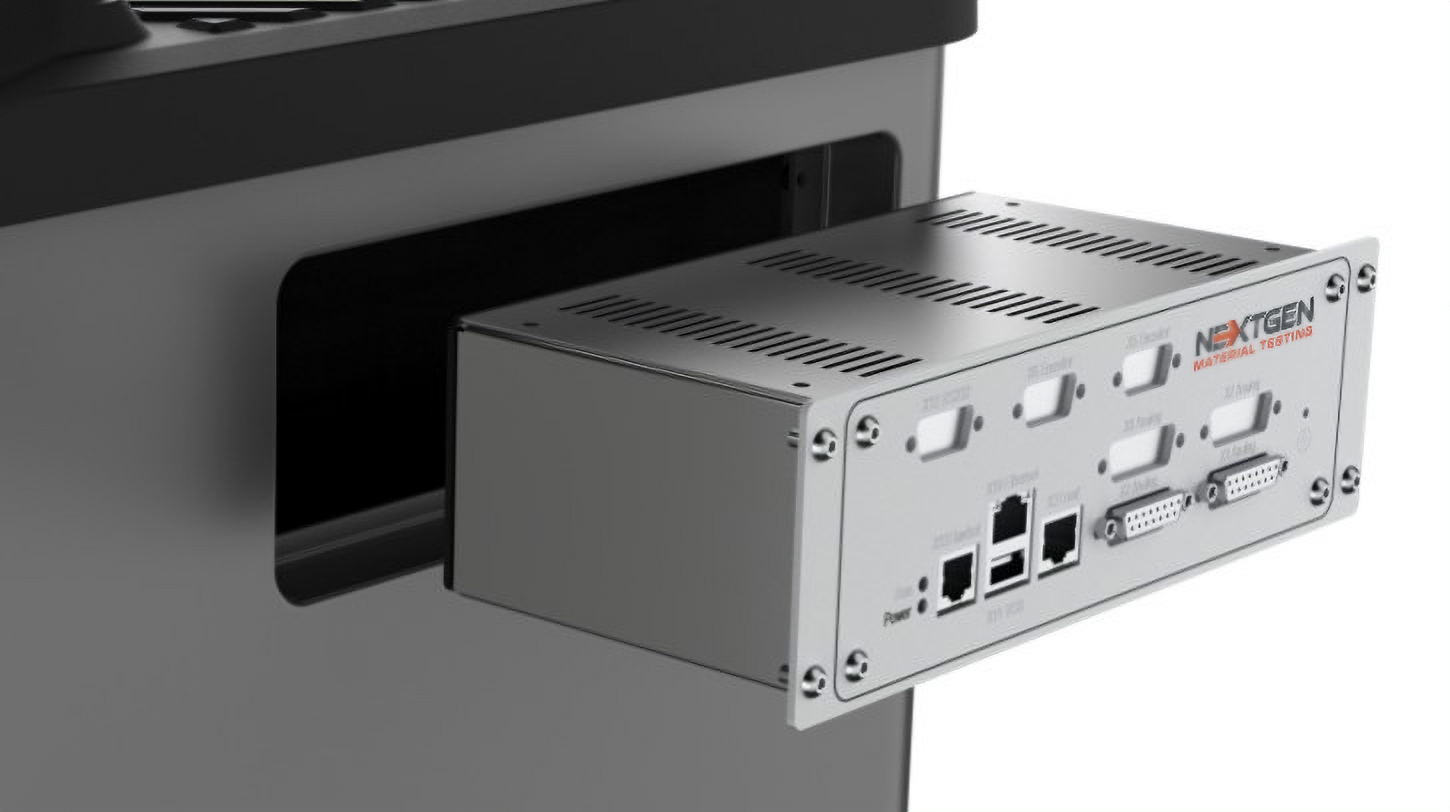
Closed-Loop Controller
The system incorporates a responsive closed-loop controller designed for test control under dynamic load conditions:
- Adaptive Feedback Control: The controller features a next-generation closed-loop PID algorithm, optimized for the upgraded direct-drive mechanics. This enables rapid system response under varying material behavior and loading profiles.
- Smooth Transition Profiles: Intelligent speed ramps and control smoothing algorithms ensure consistent performance across high-speed and low-speed regimes. This is critical for metal testing at both ambient and elevated temperatures.
- Multi-Channel Acquisition: Six synchronized analog channels and multiple digital inputs allow simultaneous integration of extensometers, temperature sensors, strain gauges, and load signals with millisecond-level accuracy.
- Real-Time Monitoring and Safety: Continuous monitoring of voltage, temperature, and sensor integrity ensures safe test execution even during long-duration or high-cycle protocols.
Live Data Visualization and Graphing
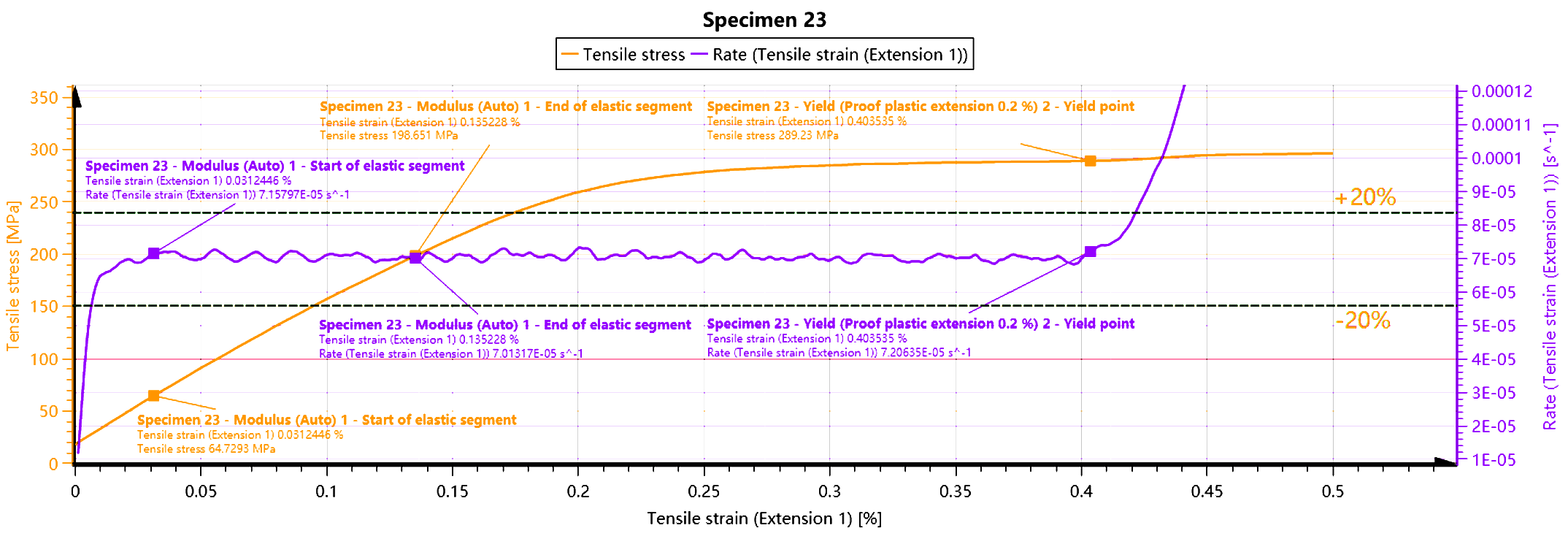

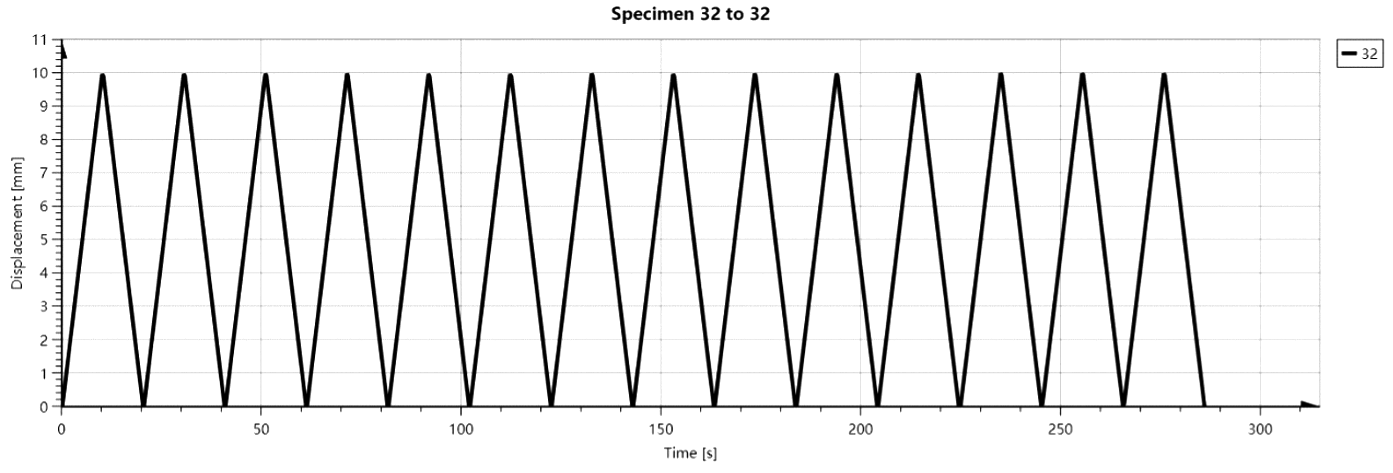
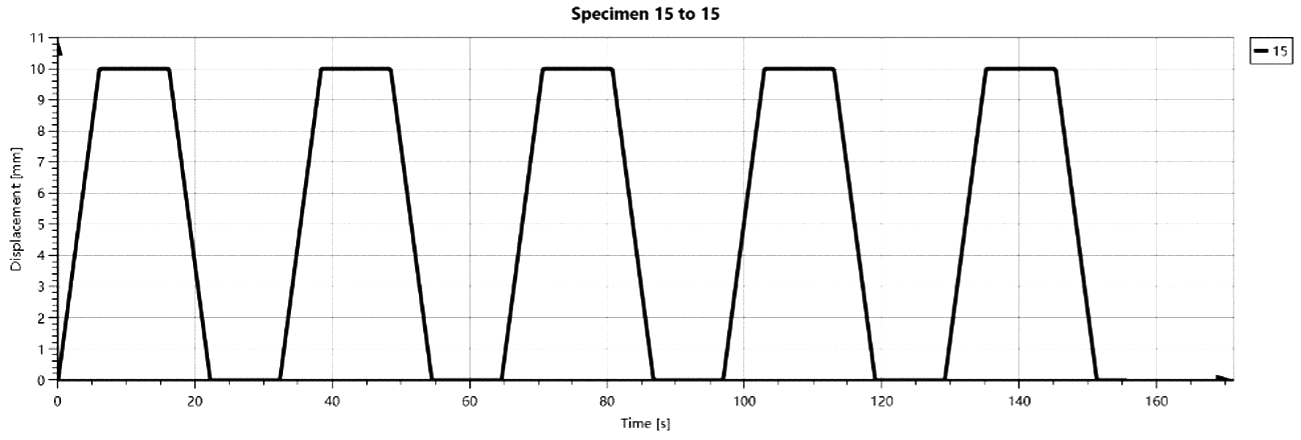

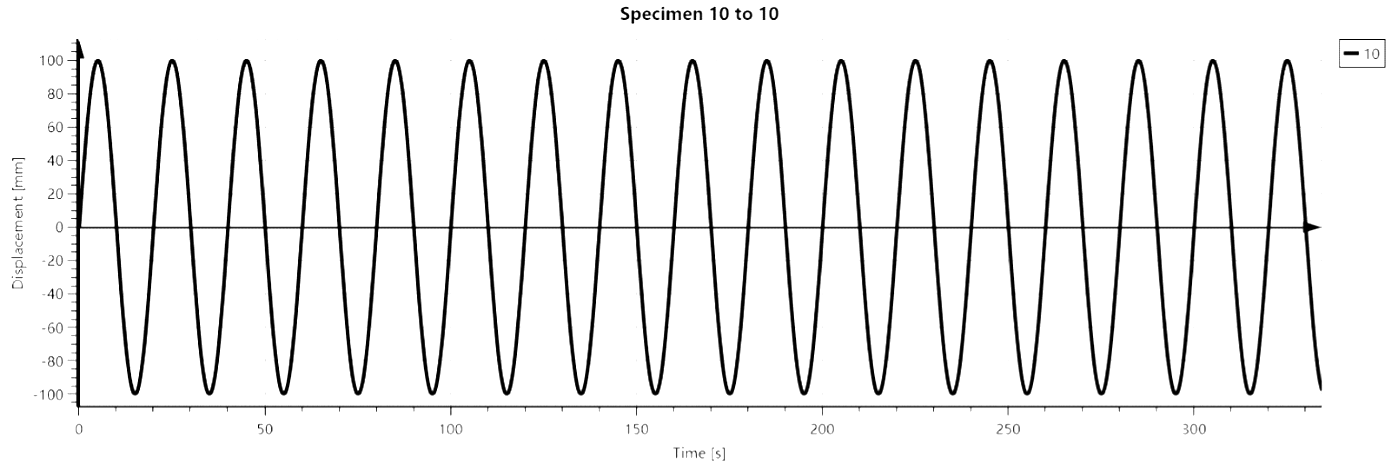
- Real-Time Graphing: During each test, the system displays synchronized force-displacement, stress-strain, and time-based curves in real time. Graphs are updated dynamically with every acquisition cycle (1200 Hz).
- Customizable Chart Layouts: Operators can define custom chart views, zoom windows, axis scaling, and data overlays for advanced comparative analysis.
- Result Markers and Zoom-In Tools: Breakpoints, yield offsets, modulus zones, and extensometer triggers are automatically marked and labeled during or after testing.
- Multiple Curve Overlays: Batch testing and comparison of multiple sample curves on a single graph allow performance consistency analysis and outlier detection.
- Export Formats: Charts and raw data can be exported in multiple formats including CSV, Excel, PDF, and graphical image (PNG, SVG).
Integrated Control Interfaces
The NG-EML Single Column Bench Top – Universal Testing Machine is engineered to support multiple control and interaction modes, providing operators with ergonomic, efficient, and flexible access to all machine functions. Whether in production, R&D, or training environments, these interfaces streamline test execution, setup, and safety control.
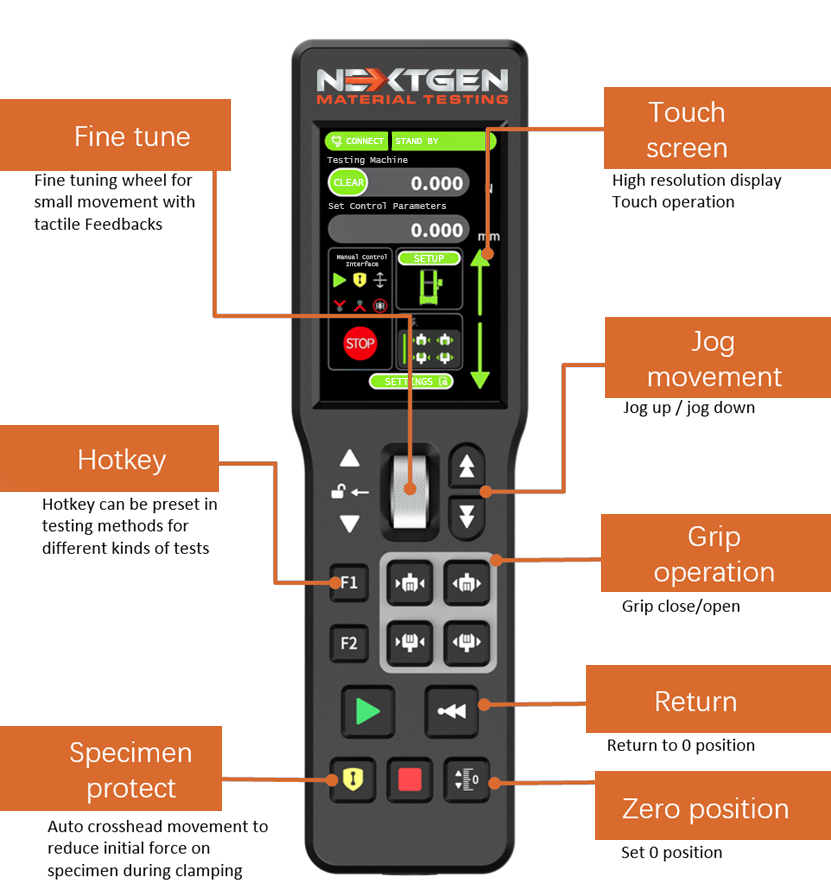
Handheld Remote Controller – Included as Standard
This compact, magnetically mountable remote handset includes a fully integrated 3.5-inch full-color touchscreen display for direct user interaction with test status and parameter control.
- Ergonomic Interface: Features silicone-coated buttons and a fine-resolution rotary wheel, which allows precise manual positioning of the crosshead. Operators can jog the crosshead, issue return-to-origin commands, or fine-tune alignment prior to clamping specimens.
- Real-Time Feedback: Live force, displacement, and system state are displayed on-screen. The user receives continuous updates, reducing the need to shift attention between the handset and PC.
- Core Control Functions:
- Start / Stop test
- Return to home position
- Manual jog of crosshead (up/down)
- Grip open/close control (if pneumatic system installed)
- Specimen protection logic – prevents excessive preload during setup
- Flexible Communication Modes: Can function either:
- In direct mode, communicating with the controller via embedded logic
- In PC-synchronized mode, acting as a secondary user input device for software-guided workflows

Optional Industrial Touchscreen PC
An optional all-in-one touchscreen computer can be mounted directly on the load frame, enabling standalone test execution without requiring an external desktop or laptop.
- GenTest™ Software Ready: The integrated industrial PC is preloaded with the full version of GenTest™ software. It provides access to all standard test method libraries, custom sequence creation, live graphing, real-time analytics, and report generation tools.
- Intuitive Touch Interface: Multi-touch screen supports tap, drag, pinch-to-zoom, and gesture control. Graphs, test results, and settings are interactively accessible on-screen, minimizing the learning curve for new users.
- Industrial-Grade Build: The PC unit features:
- Shock-absorbing housing
- Sealed surface for dust and moisture resistance
- Vibration isolation mounts (optional)
- Port Expansion: Offers multiple USB ports for data export, printer connection, barcode scanning, or peripheral automation.
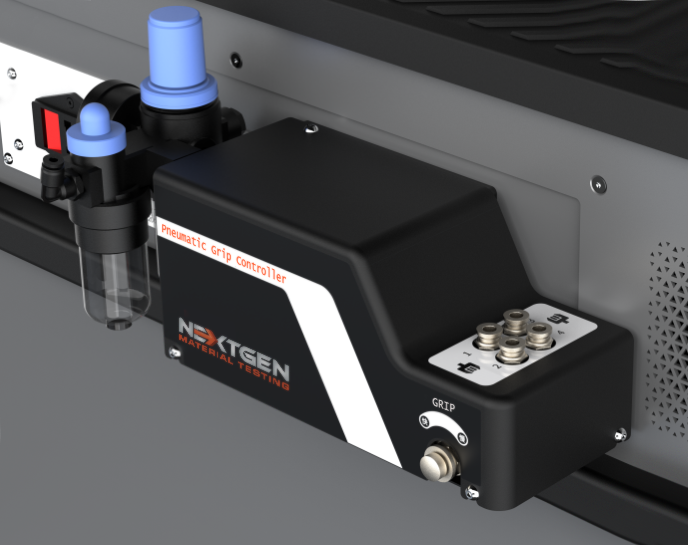
Optional Pneumatic Grip Control Module
For applications requiring pneumatic grips, the system supports an optional digital pneumatic grip pressure control unit.
- Pressure Control and Regulation: Users can set and adjust air pressure via a digital interface to match the material’s clamping requirements. Accurate pressure prevents both under-clamping (slippage) and over-clamping (material deformation).
- Dual Gripping Channels: Independently control opening and closing of upper and lower pneumatic grips for high-precision clamping sequences.
- Integrated Safety Mechanism:
- Grip actuation is disabled unless the test space is clear and the system is in a safe state
- Pre-pressure locking and relief mechanisms help maintain grip force during test start
- Compact Design: The module can be rack-mounted near the testing system or installed directly on the machine frame for easy access. Quick-connect fittings allow fast changeover of grip types.
- Visual Display: Real-time pressure feedback and grip status indicators support operator awareness and reduce the risk of setup error.
GenTest™ Software
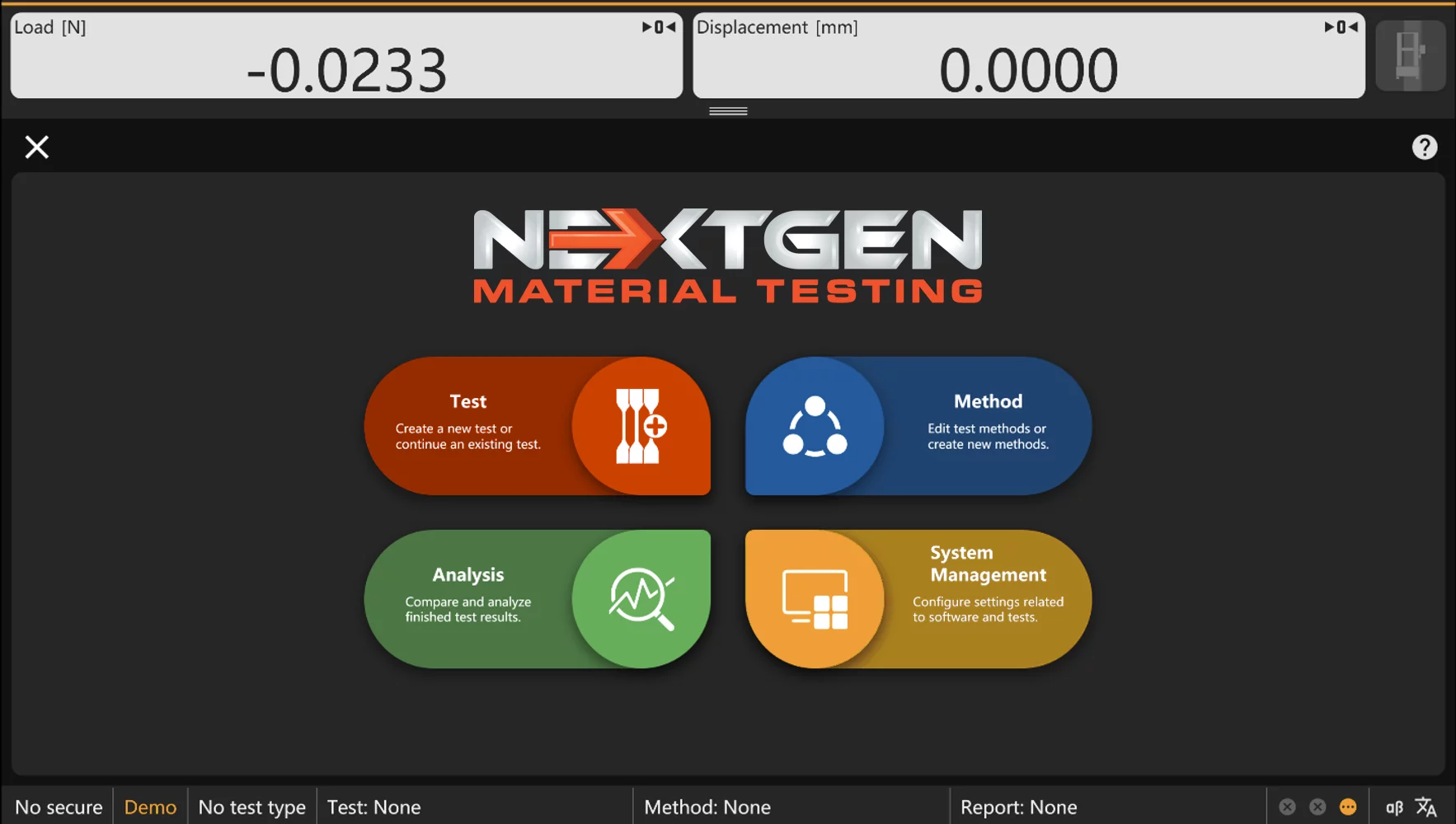
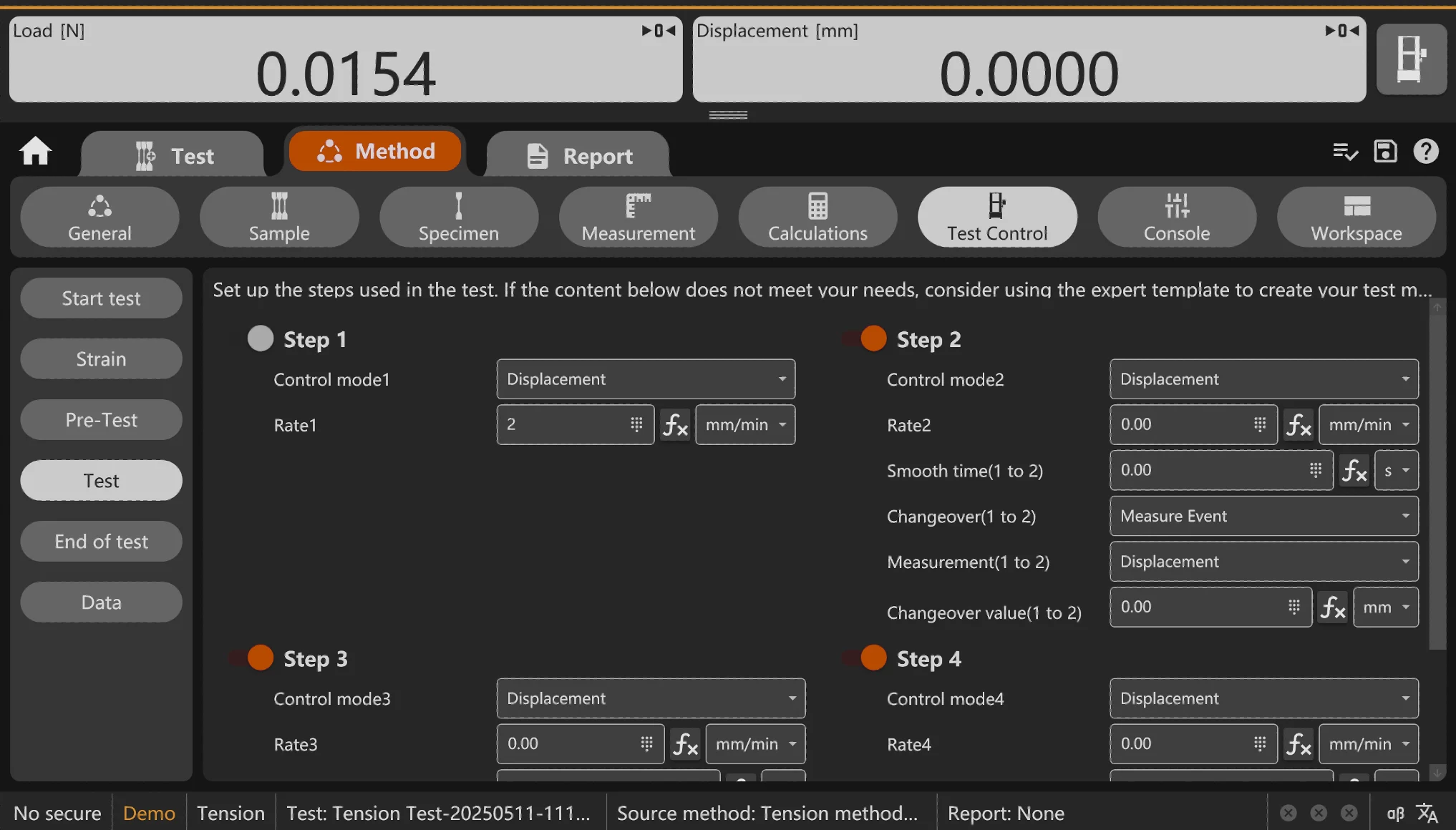
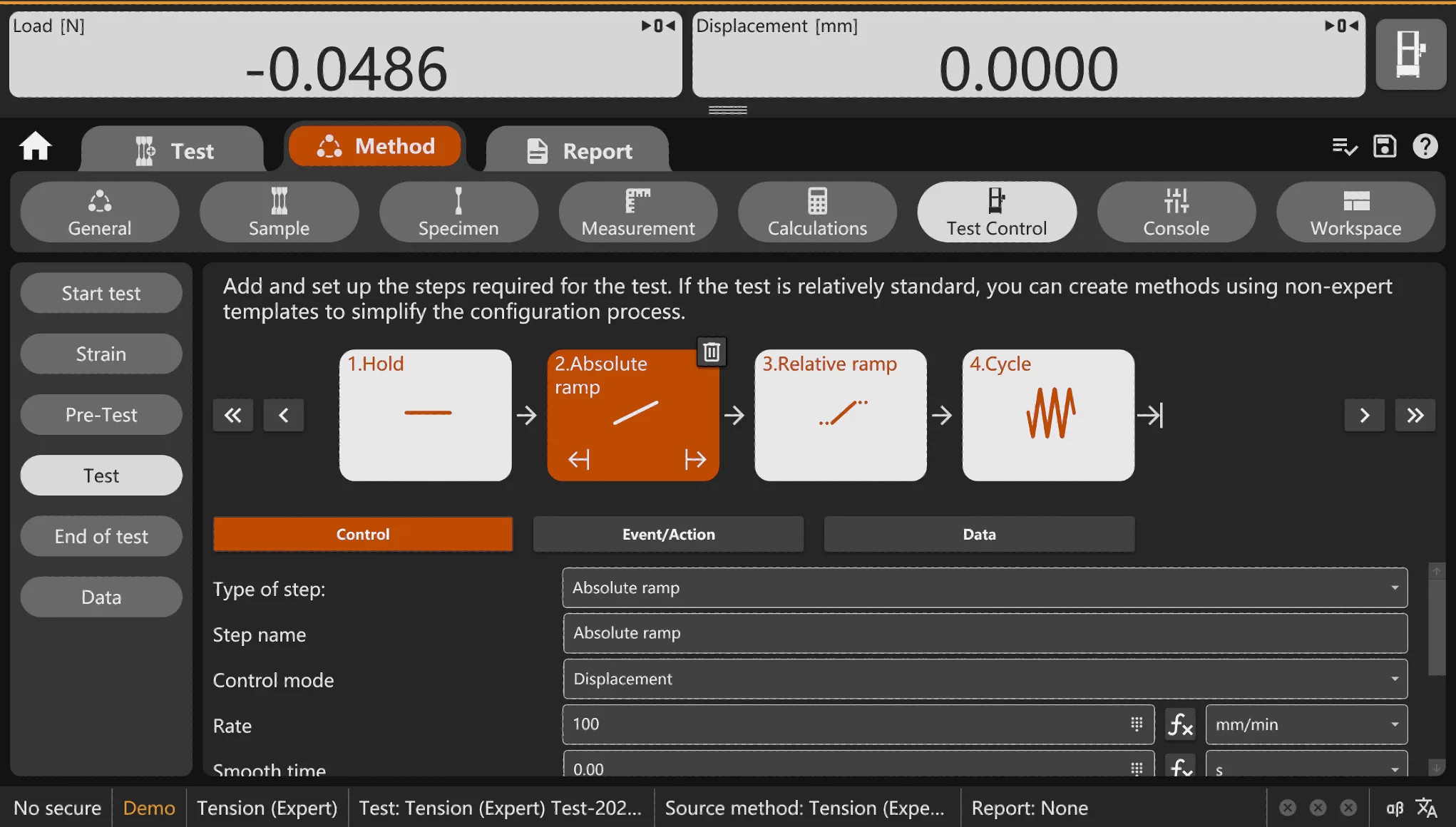
The newly updated testing software features a streamlined and intuitive layout, offering a logical arrangement of functions, consistent interface design, and clearly structured navigation. It supports both horizontal and vertical screen orientations, with automatic resolution scaling based on the display settings of the host computer.
A broad set of preloaded testing protocols is included, covering widely used standards such as GB/T, ASTM, ISO, and EN. These methods are organized into modular test groups based on application type, allowing users to efficiently select appropriate configurations for different industries and materials. In addition to standard methods, the software enables full customization of test procedures and standards to accommodate unique testing scenarios.
An integrated modular accessory management system links accessory configurations directly with the test workflow, allowing seamless interaction between the software and connected components. The platform supports a wide range of external devices, including video extensometers, temperature controllers, analog gauges, fully automatic extensometers, thermal chambers, pneumatic grip controllers, and strain measurement sensors, ensuring maximum adaptability across complex test setups.
- Interface Design: Employs a simplified, flat UI conforming to modern design standards. Optimized font display enhances readability and aesthetic coherence, improving the operator experience significantly.
- Layout and Touch Optimization: Supports both horizontal and vertical display layouts; a numeric keypad is integrated for streamlined touch-based input under operational constraints.
- Demonstration Mode: Enables simulation of tests, allowing familiarization with the software interface without physical specimen interaction.
- Recalculation: Post-test recalculation allows users to modify parameters and reprocess results efficiently.
- Test Standards: Preloaded with built-in test methods compliant with GB/T, ASTM, ISO, and EN standards, organized modularly for streamlined selection.
- Method List: Intuitive display and keyword filtering of test procedures facilitate rapid method identification and selection.
- Quick Test Method: Optimized for tensile and compression tests with minimal configuration steps.
- Data Export: One-click raw data export streamlines post-test processing.
- Test Progress Visualization: Real-time tracking of test steps, cycles, control modes, and duration provides operational transparency.
- Test Graph: Multi-mode interaction with graphs (e.g., touch, keyboard, zoom, and axis panning). Advanced plotting options support complex data visualization needs.
- Function Key Customization: Allows tailored UI controls for specific test methods, maximizing testing efficiency.
- Test Log Recording: Records comprehensive metadata including parameter inputs, system states, and abnormal events for traceability.
- Pre-test Parameter Verification: Enforces parameter validation prior to execution to eliminate procedural errors and reduce waste.
- Sample Protection Mechanism: Prevents premature damage by controlling the clamping sequence and forces.
- Real-Time Data Display: Supports up to 12 configurable channels with customizable layout, units, time formats, and refresh intervals.
- Multifunction Operation Panel: Consolidates manual control functions for connected accessories and core equipment.
- Basic Templates: Pre-configured test method templates support rapid onboarding and expert-level customization.
- Unit System: Includes metric and imperial units; conversion is automatic per selected method or test item.
- Expression Generator: Allows construction of advanced test expressions using logic or variable inputs.
- Measurement Function: Supports multi-channel data collection and live result synthesis.
- Calculation Function: Provides a suite of pre-programmed algorithms for dynamic and static calculations.
- Rounding Function: Permits configurable rounding logic in processed data to ensure result uniformity.
- Test Control: Supports step-based sequencing (ramp, hold, waveform) with customizable trigger events and acquisition strategies.
- Voice Broadcasting Function: Configurable voice prompts guide users through critical testing stages and events.
- Accessory Connection: Broad compatibility with extensometers, chambers, and other peripheral testing hardware.
- Accessory Action Control: Granular control of peripheral device behavior across the test sequence timeline.
- Data Acquisition Strategy: Customizable interval settings prevent data loss during rapid measurement changes.
- Automatic Fixture Pressure Setting: Pressure automatically adjusts based on force thresholds to prevent sample damage.
- Test Report: Full customization of report content and export format, including watermarking and formatting templates.
- Multi-language Switching: Real-time language changes without system reboot enhance international usability.
- Data Analysis: Enables inter-test and inter-batch statistical comparisons for deeper analytical insight.
- Maintenance Reminder: Intelligent system tracking prompts timely servicing to optimize hardware lifespan.
- Permission Configuration Management: Tiered access rights improve operational control and accountability.
- Safety Performance: Covers multi-dimensional safety metrics including electrical, overload, and thermal protections with real-time monitoring.
Technical Specifications
| Model | NG-EML Single Column Bench Top – Universal Testing Machine |
|---|---|
| Force Capacity | 0.01 kN (2.2 lbf) / 0.05 kN (11.2 lbf) / 0.1 kN (22.5 lbf) / 0.5 kN (112 lbf) / 1 kN (225 lbf) / 2.5 kN (562 lbf) / 5 kN (1124 lbf) |
| Frame Type | Desktop |
| Test Space | Single-zone configuration |
| Maximum Crosshead Speed | 2400 mm/min |
| Minimum Crosshead Speed | 0.00005 mm/min |
| Return Speed (Max) | 3000 mm/min |
| Position Resolution | 0.0133 µm |
| Vertical Crosshead Travel (H) | 960 mm |
| Test Width (W) | 100 mm |
| Dimensions (W × D × H) | 22.8 × 20.5 × 62.2 in (580 × 520 × 1580 mm) |
| Frame Stiffness, kN/mm | 10 kN/mm |
| Weight | 238 lbs (108 kg) |
| Power Supply | 600 W |
| Voltage | Single-phase AC 220 V ±10 %, 50 Hz / 60 Hz |
| Common Parameters | |
|---|---|
| Accuracy | Class 0.5 |
| Force Range |
500 N – 5 kN (0.2% – 100% FS) 10 N – 250 N (0.4% – 100% FS) |
| Calibration Standard | GB/T 16825.1, ISO 7500 (Class 0.5), ASTM E4 |
| Speed Accuracy | ±0.2% of set speed |
| Position Accuracy | ±0.2% of set position |
| Force Resolution | 1 / 600000 FS |
| Extension Resolution | 1 / 600000 FS |
| Strain Accuracy | Better than GB/T 228, ISO 6892-1, ASTM E8, ASTM E21 |
| Safety Protection | Overload protection (103% of rated force), position limit, over-voltage protection |
| Single-Channel Data Sampling Rate | 1200 Hz |
| Control Frequency | 1200 Hz |
| Environmental and Operational Conditions | |
|---|---|
| Working Temperature | +5 °C to +40 °C |
| Storage Temperature | −25 °C to +55 °C |
| Relative Humidity | At 20 °C, +10% to 90%, non-condensing |
| Maximum Operating Altitude | 2000 meters |
| Motor Type | AC servo motor |
| Ball Screw | Pre-loaded |
| Position Measurement | Optical encoder |
Overall Dimensions and Working Area Diagram
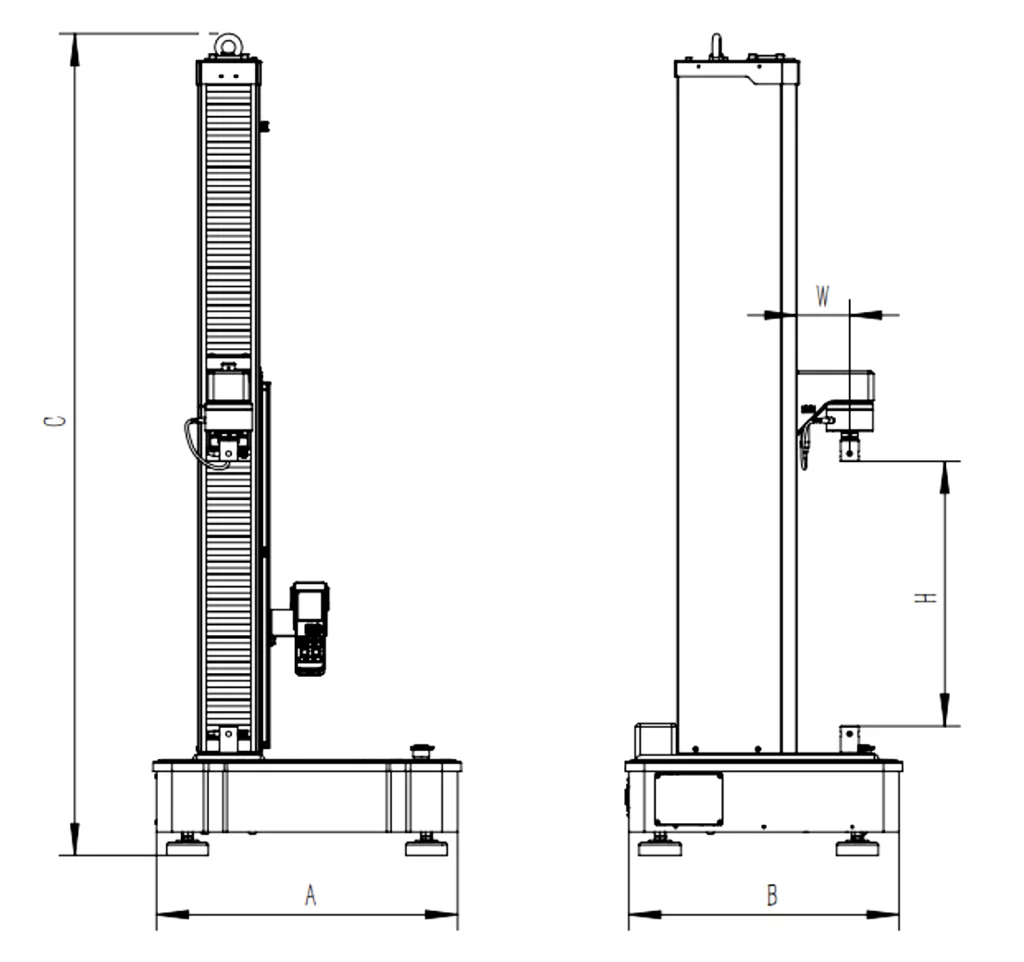
FAQs
Testing for high-strength tensile uses wedge grips. These mechanical grips are built to tighten on their own as the tensile test goes on. Based on the sample's geometry, each wedge grip must have two grip face inserts. Flat samples utilize a typical serrated grip face, whereas rounded samples employ a "Vee" insert. Some of the bigger capacity grips require the locking of a lateral door to protect the fixed wedge.
- Application: Compression test of metallic and non-metallic materials
- Maximum force: 20kN
- Connection: upper grip Φ10mm pin, lower grip is seated on the lower adapter
- Grip height:
- Upper grip (A): 65.5mm,
- Lower grip (B): 20mm
- Platen (C): Ф100mm
- Working temperature: ambient
- Test space needed: 85.5mm
- Upper grip weight: 1.8kg
- Lower grip weight: 1.6kg
Click here to obtain a personal quote today.
Flexural testing gauges a material's stiffness or resistance to bending by measuring the amount of force needed to bend a plastic beam. The material's ability to bend before permanently deforming is indicated by its flex modulus. For snap-fit assemblies or plastic lock arms, the arm must flex to facilitate appropriate connection seating and then flex back into position to lock the connection in place. If the locking mechanism is composed of brittle material, it will be more likely to shatter when bent. Flex testing for support beams, for instance, reveals how much weight the beams can sustain before bending. As a result, a rigid or stiffer material is more suited for such an application.
- Application: 3-point bending test of metallic and non-metallic materials
- Maximum force: 10kN
- Connection: upper (lower) grip: Φ10mm pin
- Height: upper grip (A): 91mm, lower grip (B): 110mm
- Total width (C): 280mm
- Working temperature: ambient
- Test space needed: 201mm
- Upper grip weight: 0.4kg
- Lower grip weight: 1.6kg
- Bending nose: R2mm, R3mm, R5mm, R7mm, exchangeable
- Support roller: R2mm, R5mm, exchangeable
- Specimen width: 40mm
- Maximum span: 160mm, adjustable
Click here to obtain a personal quote today.
To measure force, a universal testing machine (UTM) is frequently employed. A moving crosshead is part of an electromechanical system that makes up a UTM. At a predetermined rate, the crosshead moves upward (acting in tension) or downward (acting in compression). A load cell—essential to force testing—is fastened to the crosshead to evaluate the material's response to an applied force. In order to control test method characteristics such as test rate, end-of-test criteria, and test results, the software is attached to the machine.
Due to its adaptability, a UTM is referred to as "universal." A UTM may put various materials through tension, compression, bend, peel, shear, tear, and other mechanical tests. Additionally, enhancing their flexibility, these systems come in various sizes and capacities and are compatible with various load cells.
The smallest force change that a load cell can detect and, consequently, translate into a change in output voltage is referred to as resolution. The two main indicators of how a load cell will function in its lower range are resolution and accuracy.
NG-EML Class A Universal Testing Machine force accuracy is ±1% / 0.5%of reading.
Click here to obtain a personal quote today.
All objects—from toothbrushes to umbrellas to the parts of a space shuttle—are subject to forces throughout their lives. We all use forces unknowingly when carrying out routine tasks like tying a shoelace or ripping open a package. Forces are much more important to take into account in high-risk scenarios, such as when using a syringe to inject medication or operating an aeroplane. Testing is necessary to guarantee the safety and quality of every product, as well as the safety and quality of the materials and components they are created from, regardless of the application where force is being applied.
The measuring of an object's response to an applied force, often up until failure, is referred to as a force test. Force testing is used in an R&D setting to evaluate materials, assess the tensile strength of a certain material type, or create products that adhere to ergonomic or other requirements. Additionally, force testing is frequently used as a quality control measure across sectors to ensure that a particular batch of products satisfies specifications. It is crucial to comprehend how force is measured and how to measure it properly given the prevalence of force testing across sectors.
NG-EML Class A Universal Testing Machine force range is 0.2% - 100%FS/ 0.4% - 100%FS
Click here to obtain a personal quote today
Only metals test type. A certain rate of straining of the specimen's parallel slice is known as the straining rate. In extension control, it is executed. By dividing the strain rate by the gauge (parallel) length of the specimen, the provided straining rate can be converted into an equivalent crosshead speed. For instance, a specimen with a parallel length of 100mm and a rate of 1% per minute produces a crosshead speed of 1mm/min.
The Metals test type determines a suitable position rate that is close to the intended strain rate and regulates the crosshead movement at that rate throughout the ramp to which it is applied. The specimen compliance affects the actual strain rate that is attained.
Using the position rate for the elastic portion of the test is not advised because it is fixed for the entire ramp and is calculated without taking into account potential compliance factors.
NG-EML Class A Universal Testing Machine crosshead speed accuracy is ±1.0% / ±0.5% of set speed.
Click here to obtain a personal quote today.
The strain rate in test specimens is inversely proportional to the crosshead speed of the testing apparatus. The strain rate and testing temperature often influence the tensile characteristics of test materials. A natural fibre composite specimen of this size obtained by the Universal Testing Machine has a maximum strain rate that is quite constrained to less than 0.01/s. An increase in strain rate, like a drop in temperature, will often help to increase strength and possibly decrease ductility in materials like metals, polymers, and composites.
When polymeric materials exhibit viscoelastic/plastic phenomena in their deformation characteristics, the effect is frequently much more pronounced. However, there is no ideal strain rate; instead, it depends on the application for which your material may be employed.
Since the test is in extension control, the specimen's parallel length, not the extensometer's gauge length, is the gauge length utilized to calculate the strain.
NG-EML Class A Universal Testing Machine crosshead speed is 0.001 - 1000mm/min.
Click here to obtain a personal quote today.
Materials scientists strongly emphasize comprehending how a material's processing history affects its structure and, subsequently, its characteristics and functionality. The materials paradigm describes how links between processing, structure, and characteristics are understood. This paradigm is utilized to expand knowledge in a number of fields of study, including metallurgy, nanotechnology, and biomaterials.
Investigating materials, goods, buildings, or components that fail or do not work as intended and result in personal injury or property damage is a crucial component of forensic engineering and failure analysis, which also heavily relies on materials science. These kinds of investigations are essential for understanding, for instance, the reasons behind different aviation accidents and events.
Research in the field of materials science is hectic. Materials research is a collaborative effort across materials science, physics, chemistry, and other engineering departments. A few significant study fields are highlighted in the following non-exhaustive list of topics that constitutes materials research.
NG-EML Class A Universal Testing Machine dimensions & weight are:
20.85×19.3×50.8"
(53x49x129cm)
(159cm for 100cm crosshead travel)
198lbs / 90kg
Click here to obtain a personal quote today
This calibration must be done with all force indicators operational and for each force range being used. Any auxiliary equipment (such as a pointer or recorder) that has the potential to alter the force-measuring system must, while in use, undergo verification in accordance with 6.4.6. Each force-measuring system on a testing machine should be treated as a distinct testing machine if the equipment includes several force-measuring systems. For double-piston hydraulic machines, the same technique must be performed. With the following exception: employ known masses if the force to be verified is below the lower limit of the smallest capacity force-proving device used in the calibration method. The calibration must be performed using force-proving instruments.
When calibrating a force range using more than one force-proving instrument, the maximum force delivered to the smaller device must match the minimum force applied to the subsequent force-proving instrument with a higher capacity. When verifying forces with a group of known masses, the group must be regarded as a single force-proving instrument.
NG-EML Class A Universal Testing Machine complies with ISO 7500, Class 1 / Class 0.5 calibration standard.
Click here to obtain a personal quote today.
When designing ductile parts, tensile strengths are rarely essential, but they are crucial when designing brittle members. Popular materials are tabulated, including metals, composites, ceramics, polymers, and wood.
The value of a material's ultimate tensile strength does not depend on the size of the test specimen because it is an intense attribute. However, depending on the material, it might also depend on other elements, including how the specimen was prepared, whether or not there were any surface flaws, and how hot the test setting and material were.
A brittle failure occurs when a material breaks abruptly and without plastic deformation. Others that are more ductile, like the majority of metals, go through some plastic deformation and may neck before they break.
The ultimate tensile strength is often determined by doing a tensile test and observing the engineering stress vs. strain. The ultimate tensile strength is the highest point on the stress-strain curve and has stress units. The compressive strength is the corresponding point when compression takes the place of tension.
NG-EML Class A Universal Testing Machine force resolution is 1/500,000FS.
Click here to obtain a personal quote today.
The testing procedure for tensile creep is generally the same as normal testing, albeit usually at lower pressures to stay in the creep domain as opposed to plastic deformation. Additionally, specialist tensile creep testing equipment may include high-temperature furnace components that facilitate diffusion.
Utilizing strain gauges or laser gauges, the sample is maintained at a fixed temperature and tension while the material's strain is monitored. Equations controlling various creep mechanisms, such as power law or diffusion creep, can be used to fit the measured strain (see creep for more information). Analyses can be furthered by looking at the sample after a fracture. Design and material choices can benefit from understanding the creep mechanism and rate.
The NextGen long travel extensometer is a precise device for measuring strain in highly extensible materials such as elastomers, semi-rigid plastics and films.
- Gauge Length: 10mm, 20mm, 25mm, 50mm
- Measurement range: 10~ 800 mm
- Resolution: 0.01 mm
- Accuracy: 1%
- Standard: BS 5214
Click here to obtain a personal quote today.
Creep in materials, a slow plastic deformation of the material due to constant applied pressures over long periods of time, can be tested via tensile testing. The movement caused by diffusion and dislocation typically aids creep. Tensile testing is useful for materials like concrete and ceramics that behave differently in tension and compression and, as a result, have varied tensile and compressive creep rates, even though there are various ways to test creep. It is crucial to understand tensile creep to design concrete for structures that suffer tension, such as water-holding containers, or to maintain structural integrity generally.
Extensive range of accessories to meet test requirements in almost any application or industry: plastics, metals, biomedical, composites, elastomers, components, automotive, aerospace, textiles, and more.
Here are the test accessories for NG-EML Class A Universal Testing Machine:
- Tension grip
- Peel/tear fixture
- Compression fixture
- Flexure fixture
- Film COF test fixture
- Exchangeable load cells: 10N~2kN
- Long travel extensometer
- Clip-on extensometer
Click here to obtain a personal quote today.
The EML class A Series addresses the needs of standardized and routine testing, providing the user high quality at the most affordable price.
- Pre-loaded ball screws and robust bearings guarantee a long lifespan with no backlash as well as performance with low linear force and through zero. As a result, measurements are precise and reproducible, accurately reflecting specimen features instead of load frame flaws.
- Fully protected lead screw covers extend the life of the screws and increase operator safety.
- High-speed, low vibration, top-of-the-line AC servo motor and servo controller are also featured.
- Photoelectrical encoders are built into the servo motor system to measure crosshead position.
- A built-in bidirectional load cell is assembled in the middle crosshead to avoid collisions and make compression or tension tests simple.
- Dual action over-travel limits are also featured on all frames.
- Test operation is facilitated with the remote control keypad.
- The NG-400 controller has 8-CH A/D conversion for high-speed data collection.
- Complete parts and labour warranty for a year.
- Free software upgrade.
Click here to obtain a personal quote today.
The test specimen must be positioned correctly in the testing apparatus because if it is out of place, at an angle or offset to one side, the machine will apply a bending force on the specimen. This will significantly bias the results, which is hazardous for brittle materials. This scenario can be reduced by installing spherical seats or U-joints between the grips and the test machine. The specimen is misaligned in the testing apparatus if the stress-strain curve's early segment is curved rather than linear.
Extensometers are usually used to measure strain measurements. However, strain gauges are also frequently employed when measuring the Poisson's ratio or on small test specimens. Digital time, force, and elongation measurement systems are found in more recent test machines. These systems consist of electronic sensors coupled to a data-gathering tool (typically a computer) and software to manipulate and output the data. However, analogue machines are still in use today and continue to meet and surpass the accuracy standards set by ASTM, NIST, and ASM for metal tensile testing.
Here are the new features:
- Robust linear motion guide increases lateral stiffness and ensure linear crosshead travel. This results in accurate crosshead alignment thus reducing variability in measurement data and producing better overall accuracy.
- Servo motor with precise planet-gear speed reducer provides higher driving efficiency, low noise and free of maintenance. Because there is no need to replace lubricants the system’s work life is prolonged.
- Compact design saves lab space
Click here to obtain a personal quote today.
NextGen’s NG-DTC-500 digital controller offers high speed and closed loop control of load, displacement and extension.
- Imported IC, more reliable.
- Up to 1200Hz sampling frequency.
- Up to 1200Hz closed loop control frequency.
- 20bit resolution.
- 16 digital input/output port.
- Built-in port for PC communication.
- Expandable ports.
- Load protection, over-current protection, over-voltage protection, over-speed protect, and over-travel protection.
- Remote Control with Display.
- Ergonomically-designed and easy to operate.
- Fine tuning knob.
- Test start and stop operation.
- Crosshead moving up, down, jog up, jog down.
- Display of measurement channel: force, displacement, extension and etc.
- Test status display.
- Specimen protection function
Click here to obtain a personal quote today.
The machine needs to be equipped appropriately for the test specimen being used. The four primary factors are capacity, speed, accuracy, and precision. The ability of the machine to produce enough force to fracture the specimen is referred to as force capacity. To accurately simulate the actual application, the machine must be able to deliver the force either fast or slowly enough. Finally, the device must be able to measure the gauge length and forces applied with accuracy and precision; for example, a huge machine made to measure long elongations might not function with brittle material that experiences small elongations before shattering.
Software features:
- Multi-language software with built-in English and Chinese which user can customize their own translation freely.
- Pre-packaged test methods to help you quickly and efficiently meet the requirements of global test standards such as ASTM, ISO, DIN, EN, BS, and more.
- Intuitive expression for easy programming of testing standards and testing process. Testing report can be customized according to the requirement.
- User authorization: The administrator can assign different functions for different level users.
- Analysis can give typical test results like Young’s modulus, Proof stress, Yield stress, stress, strain, Tensile strength, Elongation at break, compressive strength, bending strength, etc.
Click here to obtain a personal quote today.
The universal testing machine is the most typical tensile testing apparatus. Two crossheads are used in this kind of equipment; one is powered to provide tension on the test specimen, while the other is driven to correct for the specimen's length. There are two categories: machines with hydraulic and electromagnetic propulsion systems.
The electromechanical machine moves the crosshead up or down using single, double, or four screws along with an electric motor and gear reduction system. By altering the motor's speed, a variety of crosshead speeds can be achieved. A microprocessor in the closed-loop servo controller may control the crosshead's speed, and as a result, the load rate. A single-acting or dual-acting piston is used in hydraulic testing equipment to raise or lower the crosshead. There are additional testing systems that are manually operated. The operator must change a needle valve to regulate the load rate in manual arrangements.
NG-EML Class A Universal Testing Machine uses USB 2.0 communication. Utilizing a USB 2.0 interface and moving data at a 12Mb/s speed, hardware and software exchange data. The main communication development path is toward USB, which will eventually replace other communication methods because of its high communication speed and variety of communication modes (including controlling, breaking, batch, real-time, etc.).
Click here to obtain a personal quote today.
The EML Class A Series meets the needs of routine and standardized testing while offering the user great quality at the lowest possible cost. For tension, compression, flexure, and other testing applications where load range requirements are less than 5 kN and lab space is constrained, single-column Class A testing systems are suitable. They are frequently employed for production testing and quality control.
- A broad range of robust, small single-column load frame layouts.
- Low-vibration, high-speed electromechanical drive.
- Pre-loaded, precise ball screws.
- Guides for linear motion for better alignment.
- Software that is flexible and simple to use and has a built-in industry standards library (ASTM, ISO, DIN, EN, BS, and more).
- Closed loop, high-resolution digital controllers (integrated into load frame).
- Crosshead position, overload, over temperature, over-voltage, and other limits are checked automatically.
- Extensometers, environmental systems, grips, and fittings are all available.
- Dependable test space security.
Click here to obtain a personal quote today.
A sample is put through a controlled tension until it fails in a test procedure called tensile testing, also referred to as tension testing. Ultimate tensile strength, breaking strength, maximum elongation, and reduction in the area are characteristics that a tensile test can accurately assess. These observations can all calculate Young's modulus, Poisson's ratio, yield strength, and strain-hardening characteristics. Uniaxial tensile testing is the most popular method for determining the mechanical properties of isotropic materials. Biaxial tensile testing is used with some materials. The method used to apply load to the materials differs significantly amongst various testing apparatuses.
The testing objectives and the governing test technique or specification determine how test specimens should be prepared. A standardized sample cross-section characterizes a tensile specimen in most cases. It has a gauge (section) in between the two shoulders. On average, the shoulders and grip section are 33% larger than the gauge section, making them easier to hold. The distortion and failure can also take place here due to the gauge section's reduced diameter.
Here are NG-EML Class A Universal Testing Machine typical specimens:
- Plastics
- Fine wire
- Fibers and threads
- Biomaterials
- Thin films
- Adhesives
- Foam
- Packaging
- Paper products
- Consumer products
Click here to obtain a personal quote today.
A method or technique called "metal testing" is used to determine a metallic substance's composition. Both destructive and non-destructive processes exist. Determining the characteristics of recently forged metal alloys is another aspect of metal testing. Identification of unmarked pure, common metals can be accomplished quickly and simply thanks to the availability of numerous chemical-property databases, preserving the original sample's whole, usable state.
Non-destructive testing is used in this process. However, when working with alloys (forged mixes of metals), dividing the original sample into its constituent parts may be necessary before measuring and computing the exact composition. Once the components are identified, they can be looked up and compared to alloys that are already known. In the process, the original sample would be ruined.
The most popular test procedure performed on Metals is the Corrosion resistance test.
NG-EML Class A Universal Testing Machine has the following load frame configuration: Single column, Table-top, Electromechanical.
Click here to obtain a personal quote today.
Flexible electronics are now being used more frequently. The combined electro-mechanical behaviour must be evaluated if flexible screens and sensors are to be strong and durable. The fragmentation test, or uniaxial tensile straining of the film and substrate, is the most used technique for analyzing the electrical and mechanical properties of conductive thin films used in flexible electronics. The behaviour of fracture and deformation can be assessed in situ. In situ electrical resistance measurements can provide useful information on the stretchability of metal interconnects as well as the crack onset strain of brittle layers like transparent conductors.
In situ electrical measurements in conjunction with in situ X-ray or confocal laser scanning microscopy can offer even more details regarding the mechanisms of material system breakdown. X-rays can be used to assess lattice stresses and strains, and confocal laser scanning microscopy can be used to examine cracking and buckle delamination. The integrated methodologies offer useful electrical and mechanical data that are coupled and necessary to comprehend failure causes in flexible electronics.
NG-EML Class A Universal Testing Machine force capacity is 50N, 100N, 200N, 500N, 1kN, 2kN, 5kN.
Click here to obtain a personal quote today.
Related Products
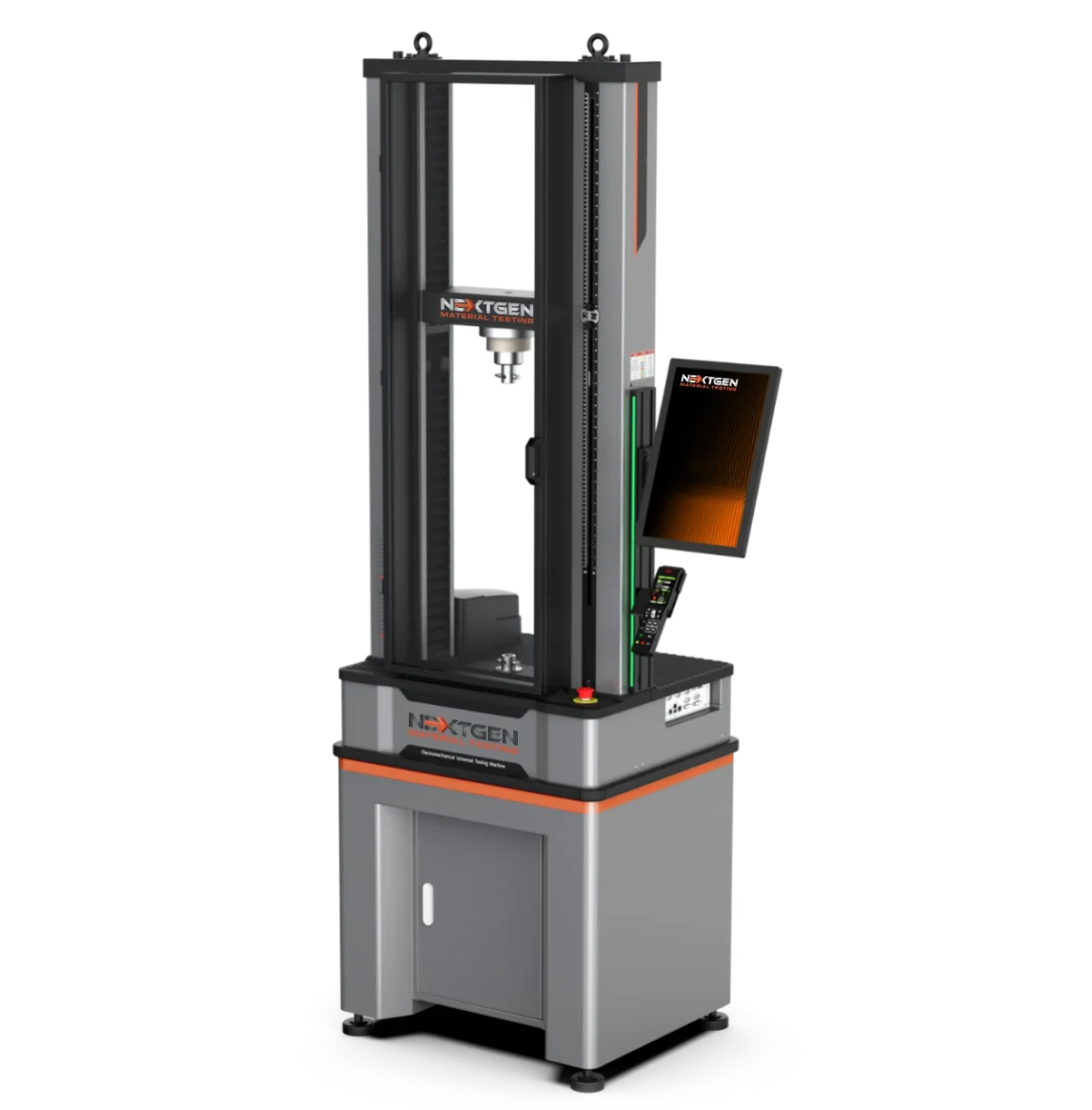
NG-EML Dual Column Bench Top - Universal Testing Machine (10N-20kN)
The dual column Class B testing systems are suited for tension, compression, flexure and other testing applications where load range requirements are between 10N to 20kN (2.24 - 4496.18 lbf). This bench top model offer a user-friendly compact solution for your universal testing needs.
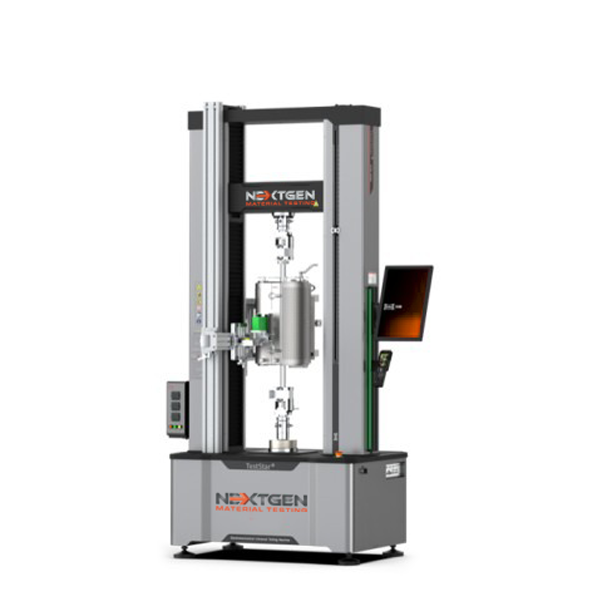
NG-EML - Dual Column Bench Top and Floor Standing - Universal Testing Machine (20kN-50kN)
The dual column Class C testing systems are suited for tension, compression, flexure and other testing applications where load range requirements are between 20kN to 50kN (4496.17 - 11240.44 lbf). The advanced load cell system offers ±0.5% accuracy down to 0.4% of capacity.
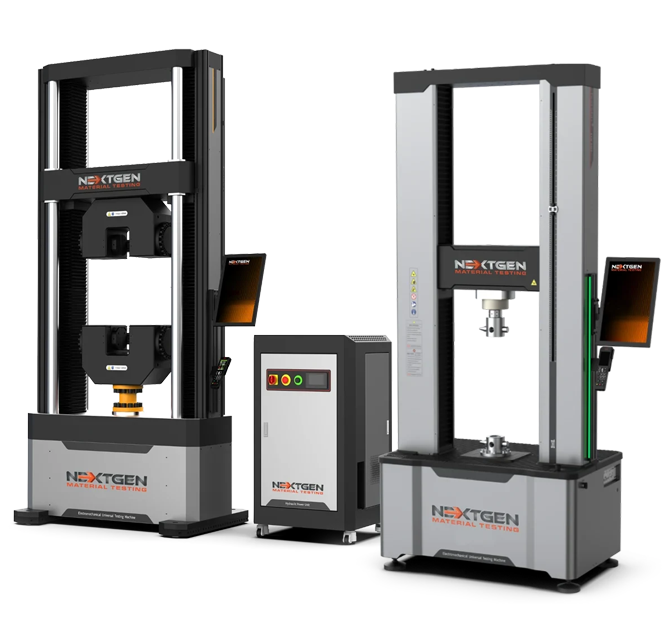
NG-EML Floor Standing - Universal Testing Machine (50kN-600kN)
The NG-EML Floor Standing - Universal Testing (Machine 50kN-600kN) are suited for tension, compression, flexure and other testing applications where load range requirements are between 50kN to 600kN (11240.44 - 134885.36 lbf). This heavy duty system offers ±0.5% reading accuracy as well as position accuracy down to 0.021μm.

Grips & Fixtures for NextGen UTM Machines
NextGen's grips and fixtures are precision-engineered accessories that transform universal testing machines into versatile systems capable of tensile, compression, flexural, shear, and other mechanical tests. Designed to meet ASTM and ISO standards, these components ensure accurate, repeatable results across various materials and applications.

GenTest Data Acquisition Software - Advanced Universal Testing Machine Software
Upgrade to GenTest, the latest data acquisition software for universal testing machines. Ensure precise, repeatable material testing with an intuitive interface, powerful analysis tools, and full compliance with ASTM, ISO, DIN, and more.
